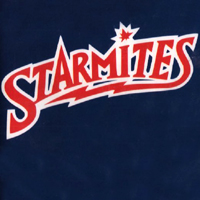 Studio Cast, 1998 (Original Cast Records)
Studio Cast, 1998 (Original Cast Records)  (1 / 5) Starmites earned six Tony Award nominations in 1989, at the end of one of the leanest Broadway musical seasons in history. All about a shy teenager named Eleanor who builds a fantasy world around the sci-fi characters in the comic books she collects, the show has mediocre but functional music and lyrics by Barry Keating, who collaborated on the book with Stuart Ross. Some of the melodies are catchy, such as the title song (which calls to mind “Little Shop of Horrors”), and others are pretty enough — for example, the “Love Duet” between Eleanor and Spacepunk, the Starmites’ “heartthrob captain.” As for the lyrics, some (“Call me macho, a hot-to-trot joe”) are more skillful than others (“Her etiquette’s so delicate”). This recording was made about nine years after the show’s Broadway run; missing are two of the original cast members, Brian Lane Green and Sharon McNight, who were the best things about the production. But Broadway cast member Liz Larsen is back as Eleanor — and, for better or worse, so is Gabriel Barre in the dual role of Trinkulus/Shak Graa. — Michael Portantiere
(1 / 5) Starmites earned six Tony Award nominations in 1989, at the end of one of the leanest Broadway musical seasons in history. All about a shy teenager named Eleanor who builds a fantasy world around the sci-fi characters in the comic books she collects, the show has mediocre but functional music and lyrics by Barry Keating, who collaborated on the book with Stuart Ross. Some of the melodies are catchy, such as the title song (which calls to mind “Little Shop of Horrors”), and others are pretty enough — for example, the “Love Duet” between Eleanor and Spacepunk, the Starmites’ “heartthrob captain.” As for the lyrics, some (“Call me macho, a hot-to-trot joe”) are more skillful than others (“Her etiquette’s so delicate”). This recording was made about nine years after the show’s Broadway run; missing are two of the original cast members, Brian Lane Green and Sharon McNight, who were the best things about the production. But Broadway cast member Liz Larsen is back as Eleanor — and, for better or worse, so is Gabriel Barre in the dual role of Trinkulus/Shak Graa. — Michael Portantiere
All posts by Michael Portantiere
Starlight Express
 Original London Cast, 1984 (Really Useful Records, 2CDs)
Original London Cast, 1984 (Really Useful Records, 2CDs)  (3 / 5) Starlight Express is the most enjoyable show — or, to look at it from another perspective, the least objectionable — that Andrew Lloyd Webber wrote after his partnership with Tim Rice broke up. With lyrics by Richard Stilgoe that are mostly fun and suitable to the story, this fantasy about anthropomorphized toy trains is rather juvenile, but at least it’s not pretentious. And the pastiche score is largely delightful. Highlights include the opening “Rolling Stock” and “Pumping Iron,” two homoerotic numbers in which the diesel engine “Greaseball” sings lead. The songs written for the female trains Belle, Dinah, and Pearl aren’t as interesting, though Dinah’s “Uncoupled” is a cute spoof of a country-western lament. The show’s title song has a soaring melody that ranks among the very best Lloyd Webber ever wrote. Oddly, while the entire company is listed on the back cover of the CD booklet for the original release of this cast album, nowhere are we informed which roles they play or which songs they sing; and though all of the lyrics sung on the album are printed in the booklet, you’ll need a magnifying glass to read them. Better to purchase these tracks as downloads. — Michael Portantiere
(3 / 5) Starlight Express is the most enjoyable show — or, to look at it from another perspective, the least objectionable — that Andrew Lloyd Webber wrote after his partnership with Tim Rice broke up. With lyrics by Richard Stilgoe that are mostly fun and suitable to the story, this fantasy about anthropomorphized toy trains is rather juvenile, but at least it’s not pretentious. And the pastiche score is largely delightful. Highlights include the opening “Rolling Stock” and “Pumping Iron,” two homoerotic numbers in which the diesel engine “Greaseball” sings lead. The songs written for the female trains Belle, Dinah, and Pearl aren’t as interesting, though Dinah’s “Uncoupled” is a cute spoof of a country-western lament. The show’s title song has a soaring melody that ranks among the very best Lloyd Webber ever wrote. Oddly, while the entire company is listed on the back cover of the CD booklet for the original release of this cast album, nowhere are we informed which roles they play or which songs they sing; and though all of the lyrics sung on the album are printed in the booklet, you’ll need a magnifying glass to read them. Better to purchase these tracks as downloads. — Michael Portantiere
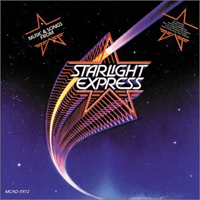 Studio Cast, 1987 (MCA)
Studio Cast, 1987 (MCA)  (2 / 5) In an introductory note for this recording, Andrew Lloyd Webber oddly describes it as a “concept album” that was made after Starlight Express had already been staged in London and New York. Even though this is not really a cast album, it’s worthy of attention because it was produced by the great Phil Ramone, and some of the singers are terrific — for example, EI DeBarge in a revised version of the title song, Richie Havens in “Light at the End of the Tunnel” and “I Am the Starlight” (a duet with Peter Hewlett). The other singers are Josie Aiello, Marc Cohn, Earl Jordan, and Harold Faltermeyer. — M.P.
(2 / 5) In an introductory note for this recording, Andrew Lloyd Webber oddly describes it as a “concept album” that was made after Starlight Express had already been staged in London and New York. Even though this is not really a cast album, it’s worthy of attention because it was produced by the great Phil Ramone, and some of the singers are terrific — for example, EI DeBarge in a revised version of the title song, Richie Havens in “Light at the End of the Tunnel” and “I Am the Starlight” (a duet with Peter Hewlett). The other singers are Josie Aiello, Marc Cohn, Earl Jordan, and Harold Faltermeyer. — M.P.
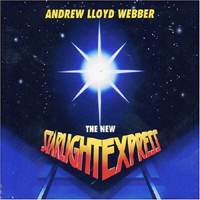 Studio Cast, 1993 (Hip-O)
Studio Cast, 1993 (Hip-O)  (3 / 5) The two-dozen tracks on this recording encompass all of the music from Starlight Express that anyone needs to hear. The songs are well performed, and there’s also some fun dialogue by “Control” (the kid who’s playing with the trains) and his mother, entertainingly delivered by Tara Wilkinson and Debbie Blankett. Greg Ellis does a fine job of singing the phenomenal title song, here arranged and orchestrated by Andrew Lloyd Webber, Nigel Wright, and David Collen. Lon Satton is Poppa, Maynard Williams is Greaseball, and Caron Cardelle is Dinah. — M.P.
(3 / 5) The two-dozen tracks on this recording encompass all of the music from Starlight Express that anyone needs to hear. The songs are well performed, and there’s also some fun dialogue by “Control” (the kid who’s playing with the trains) and his mother, entertainingly delivered by Tara Wilkinson and Debbie Blankett. Greg Ellis does a fine job of singing the phenomenal title song, here arranged and orchestrated by Andrew Lloyd Webber, Nigel Wright, and David Collen. Lon Satton is Poppa, Maynard Williams is Greaseball, and Caron Cardelle is Dinah. — M.P.
The Spitfire Grill
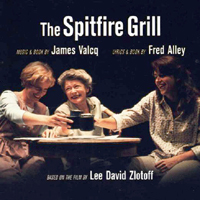 Original Off-Broadway Cast, 2001 (Triangle Road)
Original Off-Broadway Cast, 2001 (Triangle Road)  (1 / 5) About a third of the way through The Spitfire Grill, wherein a troubled young woman wanders into a sad Wisconsin hamlet and instills new hope, the sojourner and her local suitor sing the exquisite love song “This Wide Woods.” That number and one other, “Forest for the Trees,” are among the few magnets in this musical. Adapted from Lee David Zlotoff’s 1996 movie of the same title, the show is overly warm and fuzzy. Composer James Valcq and lyricist Fred Alley, who also collaborated on the book, needed to produce a more engaging score than this. For the most part, the ersatz folk tunes are quite tuneless, and too often freighted with rhymed couplets. Worse, the rhymes are not only predictable, but also scant; anytime “town” is sung, “down” nips at its footsteps, and vice versa. One driving ditty, “The Colors of Paradise,” has the characters chanting about how colorful the world has become, yet this chamber piece is almost entirely monochromatic. The cast — including Garrett Long, Phyllis Somerville, Steven Pasquale, and the always-reliable Liz Callaway — is solid, but everyone seems to be performing in shades of brown. — David Finkle
(1 / 5) About a third of the way through The Spitfire Grill, wherein a troubled young woman wanders into a sad Wisconsin hamlet and instills new hope, the sojourner and her local suitor sing the exquisite love song “This Wide Woods.” That number and one other, “Forest for the Trees,” are among the few magnets in this musical. Adapted from Lee David Zlotoff’s 1996 movie of the same title, the show is overly warm and fuzzy. Composer James Valcq and lyricist Fred Alley, who also collaborated on the book, needed to produce a more engaging score than this. For the most part, the ersatz folk tunes are quite tuneless, and too often freighted with rhymed couplets. Worse, the rhymes are not only predictable, but also scant; anytime “town” is sung, “down” nips at its footsteps, and vice versa. One driving ditty, “The Colors of Paradise,” has the characters chanting about how colorful the world has become, yet this chamber piece is almost entirely monochromatic. The cast — including Garrett Long, Phyllis Somerville, Steven Pasquale, and the always-reliable Liz Callaway — is solid, but everyone seems to be performing in shades of brown. — David Finkle
South Pacific
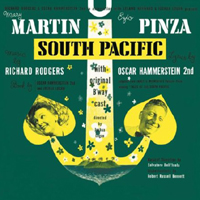 Original Broadway Cast, 1949 (Columbia/Sony)
Original Broadway Cast, 1949 (Columbia/Sony)  (5 / 5) Romantic and durable, this great Rodgers and Hammerstein score ranges from operatic to 1940s swing to quasi-Polynesian to Americana, yet each song is perfectly appropriate in terms of character and situation. Hearing the unsurpassed portrayals of the expatriate French planter Emile de Becque and U.S. navy nurse Nellie Forbush created by Ezio Pinza and Mary Martin is a sheer joy. Wonderful songs like “Some Enchanted Evening” and “A Cockeyed Optimist” were written specifically for their talents, and their interpretations of these classics remain untouched. No subsequent recording presents a more glowing performance of South Pacific. Pinza’s performance of “This Nearly Was Mine” will give you goose bumps, and the charm and heartfelt optimism of Martin’s Nellie leaps from the recording in every one of her songs, from her aforementioned introductory number to “I’m Gonna Wash That Man Right Outta My Hair” to “A Wonderful Guy” to “Honey Bun.” Juanita Hall as Bloody Mary is terrific in “Bali Ha’i” and “Happy Talk,” and as Lt. Cable, William Tabbert sings “Younger Than Springtime” and “You’ve Got to Be Carefully Taught” sweetly. Note that this album was recorded in two formats: on acetate discs, as heard on the CD edition that was released in 1998, and on magnetic tape, as heard on prior and subsequent releases. The recordings drawn from the tapes are technically superior, so be sure to acquire those through CD purchase, digital download, or whatever method you prefer. — Gerard Alessandrini
(5 / 5) Romantic and durable, this great Rodgers and Hammerstein score ranges from operatic to 1940s swing to quasi-Polynesian to Americana, yet each song is perfectly appropriate in terms of character and situation. Hearing the unsurpassed portrayals of the expatriate French planter Emile de Becque and U.S. navy nurse Nellie Forbush created by Ezio Pinza and Mary Martin is a sheer joy. Wonderful songs like “Some Enchanted Evening” and “A Cockeyed Optimist” were written specifically for their talents, and their interpretations of these classics remain untouched. No subsequent recording presents a more glowing performance of South Pacific. Pinza’s performance of “This Nearly Was Mine” will give you goose bumps, and the charm and heartfelt optimism of Martin’s Nellie leaps from the recording in every one of her songs, from her aforementioned introductory number to “I’m Gonna Wash That Man Right Outta My Hair” to “A Wonderful Guy” to “Honey Bun.” Juanita Hall as Bloody Mary is terrific in “Bali Ha’i” and “Happy Talk,” and as Lt. Cable, William Tabbert sings “Younger Than Springtime” and “You’ve Got to Be Carefully Taught” sweetly. Note that this album was recorded in two formats: on acetate discs, as heard on the CD edition that was released in 1998, and on magnetic tape, as heard on prior and subsequent releases. The recordings drawn from the tapes are technically superior, so be sure to acquire those through CD purchase, digital download, or whatever method you prefer. — Gerard Alessandrini
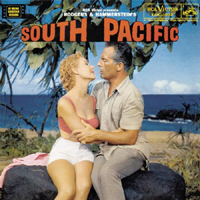 Film Soundtrack, 1958 (RCA)
Film Soundtrack, 1958 (RCA)  (5 / 5) It’s too bad that the film version of South Pacific isn’t as successful as the soundtrack album it yielded. This is a beautiful reading of the score, with excellent vocal performances by Mitzi Gaynor and Giorgio Tozzi (dubbing for Rossano Brazzi). Gaynor’s “A Wonderful Guy” is especially good, but she has many other lovely moments. Tozzi’s renditions of “Some Enchanted Evening” and “This Nearly Was Mine” differ from Pinza’s but are very beautiful in their own right; often sung pianissimo, his performances are perfect for the intimacy of film, and they come across very well on the album. Bill Lee and Muriel Smith, the vocal doubles for John Kerr and Juanita Hall, offer satisfying renditions of Lt. Cable’s and Bloody Mary’s songs. (Hall did her own fine singing as Bloody Mary on Broadway, as evidenced by the original cast album, so it’s odd that she was dubbed for the movie by Smith, who had played the role in the London production of the show.) Also heard on the album is “My Girl Back Home,” a song dropped from the stage score but reinstated for the film, along with some other music that was cut from the film itself — for example, the album contains a much fuller performance of “I’m Gonna Wash That Man Right Outta My Hair.” But the real triumphs of the movie and the soundtrack recording are the spectacular orchestrations, played by as many as 125 musicians, and Ken Darby’s splendid choral arrangements, all under the supervision of Alfred Newman. — G.A.
(5 / 5) It’s too bad that the film version of South Pacific isn’t as successful as the soundtrack album it yielded. This is a beautiful reading of the score, with excellent vocal performances by Mitzi Gaynor and Giorgio Tozzi (dubbing for Rossano Brazzi). Gaynor’s “A Wonderful Guy” is especially good, but she has many other lovely moments. Tozzi’s renditions of “Some Enchanted Evening” and “This Nearly Was Mine” differ from Pinza’s but are very beautiful in their own right; often sung pianissimo, his performances are perfect for the intimacy of film, and they come across very well on the album. Bill Lee and Muriel Smith, the vocal doubles for John Kerr and Juanita Hall, offer satisfying renditions of Lt. Cable’s and Bloody Mary’s songs. (Hall did her own fine singing as Bloody Mary on Broadway, as evidenced by the original cast album, so it’s odd that she was dubbed for the movie by Smith, who had played the role in the London production of the show.) Also heard on the album is “My Girl Back Home,” a song dropped from the stage score but reinstated for the film, along with some other music that was cut from the film itself — for example, the album contains a much fuller performance of “I’m Gonna Wash That Man Right Outta My Hair.” But the real triumphs of the movie and the soundtrack recording are the spectacular orchestrations, played by as many as 125 musicians, and Ken Darby’s splendid choral arrangements, all under the supervision of Alfred Newman. — G.A.
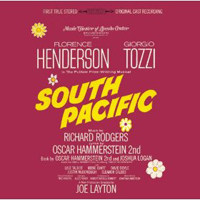 Music Theater of Lincoln Center Cast, 1967 (Columbia/Masterworks Broadway)
Music Theater of Lincoln Center Cast, 1967 (Columbia/Masterworks Broadway)  (3 / 5) Produced by Richard Rodgers himself at what was then called the New York State Theater, this South Pacific revival starred Florence Henderson, a Broadway singer in her pre-TV-sitcom days, and Giorgio Tozzi, the acclaimed operatic bass-baritone who had dubbed the singing voice of Emile for the film version about nine years earlier. Both are very impressive in their roles, and except for some flaws in the sound quality of the recording, this is a fine cast album. (It’s interesting to note that Tozzi sings “Some Enchanted Evening” in a higher key than the original as sung by Pinza. For some strange reason, that song was placed right after, rather than just before, “Bloody Mary” on the LP issues of this album, but the order has been corrected for the Masterworks Broadway CD edition. ) Irene Byatt is perfect as Bloody Mary, and Justin McDonough does a good job with Cable’s songs. As a little bonus, another future TV star, David Doyle, makes a very brief vocal appearance as Luther Billis. — G.A.
(3 / 5) Produced by Richard Rodgers himself at what was then called the New York State Theater, this South Pacific revival starred Florence Henderson, a Broadway singer in her pre-TV-sitcom days, and Giorgio Tozzi, the acclaimed operatic bass-baritone who had dubbed the singing voice of Emile for the film version about nine years earlier. Both are very impressive in their roles, and except for some flaws in the sound quality of the recording, this is a fine cast album. (It’s interesting to note that Tozzi sings “Some Enchanted Evening” in a higher key than the original as sung by Pinza. For some strange reason, that song was placed right after, rather than just before, “Bloody Mary” on the LP issues of this album, but the order has been corrected for the Masterworks Broadway CD edition. ) Irene Byatt is perfect as Bloody Mary, and Justin McDonough does a good job with Cable’s songs. As a little bonus, another future TV star, David Doyle, makes a very brief vocal appearance as Luther Billis. — G.A.
 Studio Cast, 1986 (CBS/Sony) No stars; not recommended. Although it stars opera greats Kiri Te Kanawa and José Carreras, this recording is an out-and-out failure. Te Kanawa’s voice is too sophisticated and grand for the young, naive Nellie Forbush, and Carreras’ tenor is inappropriate for the older, wiser Emile de Becque. In supporting roles, Sarah Vaughan as Bloody Mary and Mandy Patinkin as Cable are also miscast. While the recording features the London Symphony Orchestra conducted by Jonathan Tunick, the score sounds lethargic here. — G.A.
Studio Cast, 1986 (CBS/Sony) No stars; not recommended. Although it stars opera greats Kiri Te Kanawa and José Carreras, this recording is an out-and-out failure. Te Kanawa’s voice is too sophisticated and grand for the young, naive Nellie Forbush, and Carreras’ tenor is inappropriate for the older, wiser Emile de Becque. In supporting roles, Sarah Vaughan as Bloody Mary and Mandy Patinkin as Cable are also miscast. While the recording features the London Symphony Orchestra conducted by Jonathan Tunick, the score sounds lethargic here. — G.A.
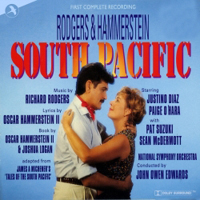 Studio Cast, 1997 (JAY, 2CDs)
Studio Cast, 1997 (JAY, 2CDs)  (2 / 5) This is a note-complete recording of the South Pacific score, but it’s not very good overall. It boasts operatic bass-baritone Justino Diaz as Emile, and Paige O’Hara, the vocal star of Disney’s wonderful animated film Beauty and the Beast, as Nellie, but their renditions of the songs lack charisma. Pat Suzuki brings spunk and mystery to Bloody Mary’s numbers, and Sean McDermott as Cable also comes across well, his beautiful tenor adding to the album’s credibility. However, John Owen Edwards’ conducting isn’t up to his usual high standards; some of his tempi are sluggish, and the performance lacks vibrancy. It’s a big plus that this is a full document of the score, including the complete overture, the entr’acte, and the scene-change music. Still, it’s more worthwhile for research than for its entertainment value. — G.A.
(2 / 5) This is a note-complete recording of the South Pacific score, but it’s not very good overall. It boasts operatic bass-baritone Justino Diaz as Emile, and Paige O’Hara, the vocal star of Disney’s wonderful animated film Beauty and the Beast, as Nellie, but their renditions of the songs lack charisma. Pat Suzuki brings spunk and mystery to Bloody Mary’s numbers, and Sean McDermott as Cable also comes across well, his beautiful tenor adding to the album’s credibility. However, John Owen Edwards’ conducting isn’t up to his usual high standards; some of his tempi are sluggish, and the performance lacks vibrancy. It’s a big plus that this is a full document of the score, including the complete overture, the entr’acte, and the scene-change music. Still, it’s more worthwhile for research than for its entertainment value. — G.A.
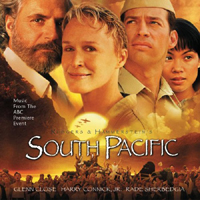 Television Film Soundtrack, 2001 (Sony)
Television Film Soundtrack, 2001 (Sony)  (2 / 5) In this soundtrack recording of the 2001 ABC-TV production of South Pacific, a mature Glenn Close is Nellie Forbush — a character who’s supposed to be no older than her late teens or early twenties. From a dramatic standpoint, Close somehow pulls it off, substituting naïveté and optimism for youth. She also sings quite adequately, having come from a Broadway musical background; her renditions of “I’m Gonna Wash That Man Right Outta My Hair” and “A Wonderful Guy” are effective. In the men’s roles, Rade Serbedzija’s voice lacks the musicality and resonance for Emile de Becque’s ballads, so his performances of these beautiful songs are very disappointing. Harry Connick, Jr. as Lt. Cable sounds like a crooner and lacks enthusiasm in his rendition of “Younger Than Springtime.” Lori Tan Chinn as Bloody Mary does fairly well singing “Bali Hai,” but “Happy Talk” is not in the TV film and not on this recording. However, included as a bonus track is “My Girl Back Home,” a charming song that was dropped from the original Broadway stage production and was recorded by Connick and Cose but not restored for this film itself. Overall, the recording leaves a lot to be desired. The best number is “There Is Nothin’ Like a Dame,” performed with spirit and energy. (Robert Pastorelli as Billis is a lot of fun.) But most of the arrangements and orchestrations are moody, overly atmospheric, and ultimately quite bland. If you are a wild fan of Glenn Close, this one’s for you, but, if you want a satisfying recording of the score of South Pacific, there’s no need to consider it as an option. — G.A.
(2 / 5) In this soundtrack recording of the 2001 ABC-TV production of South Pacific, a mature Glenn Close is Nellie Forbush — a character who’s supposed to be no older than her late teens or early twenties. From a dramatic standpoint, Close somehow pulls it off, substituting naïveté and optimism for youth. She also sings quite adequately, having come from a Broadway musical background; her renditions of “I’m Gonna Wash That Man Right Outta My Hair” and “A Wonderful Guy” are effective. In the men’s roles, Rade Serbedzija’s voice lacks the musicality and resonance for Emile de Becque’s ballads, so his performances of these beautiful songs are very disappointing. Harry Connick, Jr. as Lt. Cable sounds like a crooner and lacks enthusiasm in his rendition of “Younger Than Springtime.” Lori Tan Chinn as Bloody Mary does fairly well singing “Bali Hai,” but “Happy Talk” is not in the TV film and not on this recording. However, included as a bonus track is “My Girl Back Home,” a charming song that was dropped from the original Broadway stage production and was recorded by Connick and Cose but not restored for this film itself. Overall, the recording leaves a lot to be desired. The best number is “There Is Nothin’ Like a Dame,” performed with spirit and energy. (Robert Pastorelli as Billis is a lot of fun.) But most of the arrangements and orchestrations are moody, overly atmospheric, and ultimately quite bland. If you are a wild fan of Glenn Close, this one’s for you, but, if you want a satisfying recording of the score of South Pacific, there’s no need to consider it as an option. — G.A.
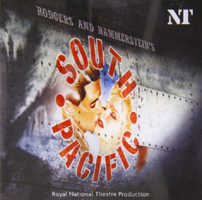 Royal National Theater Cast, 2002 (First Night)
Royal National Theater Cast, 2002 (First Night)  (2 / 5) Although the score is conducted with passion by Stephen Brooker, this cast album of Trevor Nunn’s production of South Pacific features some less-than-stellar vocal performances and some unfortunate rearrangements of the music. As Emile, Philip Quast is the most effective of the four leads; his rich baritone is melodic, despite the bleat in his vibrato at times, and he conveys the right romantic fervor in the role. But Lauren Kennedy’s Nellie has a twang and nasality that can be cloying. Although Sheila Francisco is well cast as Bloody Mary, the throatiness of her voice is distracting. Edward Baker Duly as Cable displays a tenor that’s fine, yet not distinctive. On the plus side, this recording includes “Now Is the Time,” a brisk, march-tempo song for Emile and Cable that was dropped from the score before the show’s New York premiere. There is also a good amount of dialogue and underscoring, plus some reprises not included on previous recordings. — G.A.
(2 / 5) Although the score is conducted with passion by Stephen Brooker, this cast album of Trevor Nunn’s production of South Pacific features some less-than-stellar vocal performances and some unfortunate rearrangements of the music. As Emile, Philip Quast is the most effective of the four leads; his rich baritone is melodic, despite the bleat in his vibrato at times, and he conveys the right romantic fervor in the role. But Lauren Kennedy’s Nellie has a twang and nasality that can be cloying. Although Sheila Francisco is well cast as Bloody Mary, the throatiness of her voice is distracting. Edward Baker Duly as Cable displays a tenor that’s fine, yet not distinctive. On the plus side, this recording includes “Now Is the Time,” a brisk, march-tempo song for Emile and Cable that was dropped from the score before the show’s New York premiere. There is also a good amount of dialogue and underscoring, plus some reprises not included on previous recordings. — G.A.
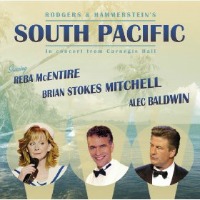 Carnegie Hall Concert Cast, 2006 (Verve)
Carnegie Hall Concert Cast, 2006 (Verve)  (2 / 5) This recording is taken from a concert performance at Carnegie Hall that was also telecast on PBS. It has a tentative quality that many quickly assembled concerts tend to have, and it lacks the pace and energy of a cast album of a full stage production. It also features, for better or worse, the kind of famous names that can draw a crowd for a concert in a major hall and a TV broadcast. In this case, Reba McEntire and Brian Stokes Mitchell are fairly well suited to the roles of Nellie and Emile, while Alec Baldwin as Luther Billis falls more into the category of stunt casting than perfect casting. McEntire gives a colorful and spirited performance, but her country singer’s twang is far too exaggerated to permit a proper interpretation of Ensign Nellie Forbush. While Mitchell sings magnificently, his contemporary stylistic choices seem anachronistic to the score; his renditions of the classic songs “Some Enchanted Evening” and “This Nearly Was Mine” are better characterized as “good covers” than effective dramatic performances. Jason Danieley is well cast as Lt. Cable, but Lillias White as Bloody Mary also gives more of a star turn than a valid interpretation of this character role. Further working against the appeal of this recording, the large chunks of dialogue from the show’s book seem under-rehearsed to the point of annoyance, while the Orchestra of St. Luke’s also sounds a bit unrehearsed and sometimes lacking in energy as conducted by Paul Gemignani. Overall, the album is interesting and occasionally fun, but it’s not a good representation of this magnificent musical as a piece of theater. — G.A.
(2 / 5) This recording is taken from a concert performance at Carnegie Hall that was also telecast on PBS. It has a tentative quality that many quickly assembled concerts tend to have, and it lacks the pace and energy of a cast album of a full stage production. It also features, for better or worse, the kind of famous names that can draw a crowd for a concert in a major hall and a TV broadcast. In this case, Reba McEntire and Brian Stokes Mitchell are fairly well suited to the roles of Nellie and Emile, while Alec Baldwin as Luther Billis falls more into the category of stunt casting than perfect casting. McEntire gives a colorful and spirited performance, but her country singer’s twang is far too exaggerated to permit a proper interpretation of Ensign Nellie Forbush. While Mitchell sings magnificently, his contemporary stylistic choices seem anachronistic to the score; his renditions of the classic songs “Some Enchanted Evening” and “This Nearly Was Mine” are better characterized as “good covers” than effective dramatic performances. Jason Danieley is well cast as Lt. Cable, but Lillias White as Bloody Mary also gives more of a star turn than a valid interpretation of this character role. Further working against the appeal of this recording, the large chunks of dialogue from the show’s book seem under-rehearsed to the point of annoyance, while the Orchestra of St. Luke’s also sounds a bit unrehearsed and sometimes lacking in energy as conducted by Paul Gemignani. Overall, the album is interesting and occasionally fun, but it’s not a good representation of this magnificent musical as a piece of theater. — G.A.
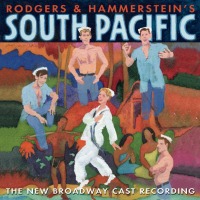 Broadway Cast, 2008 (Masterworks Broadway)
Broadway Cast, 2008 (Masterworks Broadway)  (4 / 5) Here is an excellent recording of the classic Rodgers & Hammerstein score. In many ways, it’s the best audio-only representation of South Pacific as a dramatic piece. The completeness of the recording and its superb sound quality give a vivid aural picture of the wonderful Lincoln Center Theater revival, with what may be the best cast since the original production in 1949. The performances of Kelli O’Hara as Nellie and Paulo Szot (2008 Tony Award winner for Best Actor in a Musical) as Emile are very honest and never give in to show-biz campiness, as is sometimes found in recordings of older scores; the two stars take the material seriously and give us three-dimensional characters as written by Rodgers & Hammerstein and Joshua Logan, co-author of the show’s book. Danny Burstein as Billis and Loretta Ables Sayre as Bloody Mary are just as well cast, while Mathew Morrison as Lt. Cable adds youth, sex appeal, and vigor to the recording. The show’s original orchestrations are beautifully captured here in digital stereo, and have never sounded better. The album also contains some interesting hidden bonus items, such as the orchestral portions of “A Wonderful Guy” and “Some Enchanted Evening” minus the vocal tracks, so you can sing ’em yourself like Karaoke! This production’s great success proved that classic musicals needn’t be re-written, re-orchestrated, or cast with pop stars to achieve favor with modern audiences, and the cast album is a must for anyone wanting a first-rate, 21st-century recording of a timeless show. — G.A.
(4 / 5) Here is an excellent recording of the classic Rodgers & Hammerstein score. In many ways, it’s the best audio-only representation of South Pacific as a dramatic piece. The completeness of the recording and its superb sound quality give a vivid aural picture of the wonderful Lincoln Center Theater revival, with what may be the best cast since the original production in 1949. The performances of Kelli O’Hara as Nellie and Paulo Szot (2008 Tony Award winner for Best Actor in a Musical) as Emile are very honest and never give in to show-biz campiness, as is sometimes found in recordings of older scores; the two stars take the material seriously and give us three-dimensional characters as written by Rodgers & Hammerstein and Joshua Logan, co-author of the show’s book. Danny Burstein as Billis and Loretta Ables Sayre as Bloody Mary are just as well cast, while Mathew Morrison as Lt. Cable adds youth, sex appeal, and vigor to the recording. The show’s original orchestrations are beautifully captured here in digital stereo, and have never sounded better. The album also contains some interesting hidden bonus items, such as the orchestral portions of “A Wonderful Guy” and “Some Enchanted Evening” minus the vocal tracks, so you can sing ’em yourself like Karaoke! This production’s great success proved that classic musicals needn’t be re-written, re-orchestrated, or cast with pop stars to achieve favor with modern audiences, and the cast album is a must for anyone wanting a first-rate, 21st-century recording of a timeless show. — G.A.
The Sound of Music
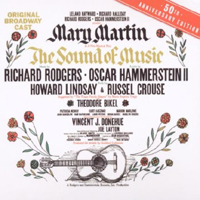 Original Broadway Cast, 1959 (Columbia/Sony)
Original Broadway Cast, 1959 (Columbia/Sony)  (5 / 5) Although excellent, this recording of the Rodgers and Hammerstein classic has been so overshadowed by the spectacularly popular film soundtrack album that it’s difficult to judge it on its own merits. Mary Martin is in good voice as Maria and seems perfectly matched to the material, yet her interpretation of the character differs greatly from that offered by Julie Andrews; Martin is more wistful, delivering the title song with a deeper, plaintive quality. As conducted by Frederick Dvonch, the score in general has a more legit tone here than it does on the soundtrack recording, and Patricia Neway brings full operatic beauty and power to the role of the Mother Abbess. Theodore Bikel is a strong presence as Captain Von Trapp. Kurt Kasznar and Marion Marlowe as Max Detweiler and Elsa Schraeder are also standouts; they perform “How Can Love Survive?” and “No Way to Stop It” delightfully. The children, including Lauri Peters as Liesl, exude warmth. From a technical and musical standpoint, this Sound of Music album is highly commendable, and as a record of the final Rodgers and Hammerstein score, it’s a must for serious collectors of transcendent musical theater. — Gerard Alessandrini
(5 / 5) Although excellent, this recording of the Rodgers and Hammerstein classic has been so overshadowed by the spectacularly popular film soundtrack album that it’s difficult to judge it on its own merits. Mary Martin is in good voice as Maria and seems perfectly matched to the material, yet her interpretation of the character differs greatly from that offered by Julie Andrews; Martin is more wistful, delivering the title song with a deeper, plaintive quality. As conducted by Frederick Dvonch, the score in general has a more legit tone here than it does on the soundtrack recording, and Patricia Neway brings full operatic beauty and power to the role of the Mother Abbess. Theodore Bikel is a strong presence as Captain Von Trapp. Kurt Kasznar and Marion Marlowe as Max Detweiler and Elsa Schraeder are also standouts; they perform “How Can Love Survive?” and “No Way to Stop It” delightfully. The children, including Lauri Peters as Liesl, exude warmth. From a technical and musical standpoint, this Sound of Music album is highly commendable, and as a record of the final Rodgers and Hammerstein score, it’s a must for serious collectors of transcendent musical theater. — Gerard Alessandrini
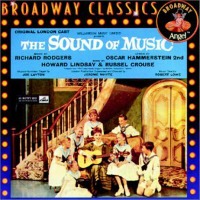 Original London Cast, 1961 (HMV/Angel)
Original London Cast, 1961 (HMV/Angel)  (4 / 5) The first London production of The Sound Of Music opened in May of 1961, a year and a half after the show premiered on Broadway. By that time, Oscar Hammerstein had died, and the show had attained a growing respect from critics, some of whom were skeptical when it first opened in New York in 1959. Also, the title of the show had gained international fame, so major stars weren’t needed to launch this West End production. On the recording, we hear Jean Bayless as Maria, Constance Shacklock as the Mother Abbess, and Roger Dann as Captain Von Trapp. Eunice Gayson and Harold Kasket are Elsa and Max, and their performances are very appealing and appropriate. Although none of this quintet are thought of as major stars, they all make lovely sounding music — and the emphasis here is on the music. By 1961, practically the whole world had come to agree on the excellence of Richard Rodgers’ score for this show, and here it’s treated with the utmost respect and care. Compared to the 1959 original and the later 1965 motion picture soundtrack, the album has more of a classical sound to it, with some slower tempos. Bayless has a lovely, strong, legit soprano voice, and her interpretation of Maria is warm and compelling. Shacklock also has a fine operatic instrument; her performance of “Climb Every Mountain” is quite grand, even a bit Wagnerian. Overall, this recording of The Sound Of Music isn’t at the top of the list, but it’s very enjoyable in its own right. — G.A.
(4 / 5) The first London production of The Sound Of Music opened in May of 1961, a year and a half after the show premiered on Broadway. By that time, Oscar Hammerstein had died, and the show had attained a growing respect from critics, some of whom were skeptical when it first opened in New York in 1959. Also, the title of the show had gained international fame, so major stars weren’t needed to launch this West End production. On the recording, we hear Jean Bayless as Maria, Constance Shacklock as the Mother Abbess, and Roger Dann as Captain Von Trapp. Eunice Gayson and Harold Kasket are Elsa and Max, and their performances are very appealing and appropriate. Although none of this quintet are thought of as major stars, they all make lovely sounding music — and the emphasis here is on the music. By 1961, practically the whole world had come to agree on the excellence of Richard Rodgers’ score for this show, and here it’s treated with the utmost respect and care. Compared to the 1959 original and the later 1965 motion picture soundtrack, the album has more of a classical sound to it, with some slower tempos. Bayless has a lovely, strong, legit soprano voice, and her interpretation of Maria is warm and compelling. Shacklock also has a fine operatic instrument; her performance of “Climb Every Mountain” is quite grand, even a bit Wagnerian. Overall, this recording of The Sound Of Music isn’t at the top of the list, but it’s very enjoyable in its own right. — G.A.
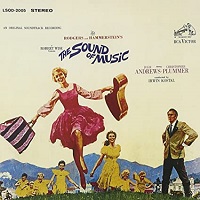 Film Soundtrack, 1965 (RCA)
Film Soundtrack, 1965 (RCA)  (5 / 5) One of the principal reasons for the enduring appeal of the hugely successful Sound of Music film and soundtrack album is the fresh approach given to the material. Julie Andrews brings wit, spirit, and buoyancy to the role of Maria. Perfectly sung and brilliantly acted, Andrews’ great performance is also notable for her clear but unaffected diction, and she knows exactly which lines to sing, which ones to exclaim. The songs of the Captain and the Mother Abbess are very well sung by Bill Lee and Margery McKay, respectively, dubbing for Christopher Plummer and Peggy Wood. McKay’s rendition of “Climb Every Mountain” is notably stirring. Charmian Carr does her own singing as Liesl; she’s charming in “Sixteen Going on Seventeen” with Dan Truhitte as Rolf, and in all of her tracks with the children. Since the two songs allotted to Elsa and Max in the show score, “How Can Love Survive?” and “No Way to Stop It,” are not included in the film, neither Eleanor Parker nor Richard Haydn (nor any vocal doubles for them who might have been employed) are heard on the soundtrack album. The arrangements and orchestrations of the film’s music overall are bright, uplifting, and thoroughly delightful from beginning to end. — G.A.
(5 / 5) One of the principal reasons for the enduring appeal of the hugely successful Sound of Music film and soundtrack album is the fresh approach given to the material. Julie Andrews brings wit, spirit, and buoyancy to the role of Maria. Perfectly sung and brilliantly acted, Andrews’ great performance is also notable for her clear but unaffected diction, and she knows exactly which lines to sing, which ones to exclaim. The songs of the Captain and the Mother Abbess are very well sung by Bill Lee and Margery McKay, respectively, dubbing for Christopher Plummer and Peggy Wood. McKay’s rendition of “Climb Every Mountain” is notably stirring. Charmian Carr does her own singing as Liesl; she’s charming in “Sixteen Going on Seventeen” with Dan Truhitte as Rolf, and in all of her tracks with the children. Since the two songs allotted to Elsa and Max in the show score, “How Can Love Survive?” and “No Way to Stop It,” are not included in the film, neither Eleanor Parker nor Richard Haydn (nor any vocal doubles for them who might have been employed) are heard on the soundtrack album. The arrangements and orchestrations of the film’s music overall are bright, uplifting, and thoroughly delightful from beginning to end. — G.A.
 London Cast, 1981 (Epic/no CD)
London Cast, 1981 (Epic/no CD)  (4 / 5) Here’s a vibrant performance of The Sound of Music. In fact, this is the only stage cast album of the score that seems to catch the joyous excitement of the forever popular movie, due in part to rich new orchestrations and the exceptionally clear sound quality of the recording. Petula Clark comes off very well as Maria and is firmly supported by her fellow cast members, all of whom excel in their roles: Michael Jayston as Captain Von Trapp, Honor Blackman as Elsa, and June Bronhill as the Mother Abbess. “My Favorite Things,” “Sixteen Going on Seventeen,” and many of the show’s other songs were moved around for this production, but it’s all done tastefully and effectively. — G.A.
(4 / 5) Here’s a vibrant performance of The Sound of Music. In fact, this is the only stage cast album of the score that seems to catch the joyous excitement of the forever popular movie, due in part to rich new orchestrations and the exceptionally clear sound quality of the recording. Petula Clark comes off very well as Maria and is firmly supported by her fellow cast members, all of whom excel in their roles: Michael Jayston as Captain Von Trapp, Honor Blackman as Elsa, and June Bronhill as the Mother Abbess. “My Favorite Things,” “Sixteen Going on Seventeen,” and many of the show’s other songs were moved around for this production, but it’s all done tastefully and effectively. — G.A.
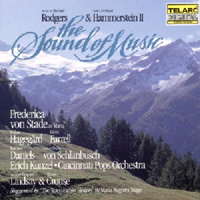 Studio Cast, 1987 (Telstar)
Studio Cast, 1987 (Telstar)  (2 / 5) This recording features a large orchestra and several classically trained singers, so it has a grand-opera feel about it, yet it lacks the theatrical energy often heard on stage cast albums. Frederica von Stade sings Maria’s songs with rich, round tone. While she may not be fully convincing in this role from a dramatic standpoint, her lovely voice mostly lends itself well to the beautiful Rodgers and Hammerstein score. But the nuns, some of the children, and Rolf (Neil Jones) sound a little stiff, and the charm of the character roles of Max and Elsa are obliterated by the hugely operatic performances of Lewis Dahle von Schlanbusch and Barbara Daniels; their rendition of the comic gem “How Can Love Survive?” is way off the mark. As Captain Von Trapp, Håkan Hagegård sounds more appropriate, but not very exciting. The vocal highlight of the recording is Eileen Farrell’s exquisite rendition of “Climb Every Mountain.” Erich Kunzel conducts the Cincinnati Pops Orchestra with no particular zest. In sum, the recording is of interest primarily to those who are curious to hear what this musical might sound like if it entered the repertoire of the Metropolitan Opera. — G.A.
(2 / 5) This recording features a large orchestra and several classically trained singers, so it has a grand-opera feel about it, yet it lacks the theatrical energy often heard on stage cast albums. Frederica von Stade sings Maria’s songs with rich, round tone. While she may not be fully convincing in this role from a dramatic standpoint, her lovely voice mostly lends itself well to the beautiful Rodgers and Hammerstein score. But the nuns, some of the children, and Rolf (Neil Jones) sound a little stiff, and the charm of the character roles of Max and Elsa are obliterated by the hugely operatic performances of Lewis Dahle von Schlanbusch and Barbara Daniels; their rendition of the comic gem “How Can Love Survive?” is way off the mark. As Captain Von Trapp, Håkan Hagegård sounds more appropriate, but not very exciting. The vocal highlight of the recording is Eileen Farrell’s exquisite rendition of “Climb Every Mountain.” Erich Kunzel conducts the Cincinnati Pops Orchestra with no particular zest. In sum, the recording is of interest primarily to those who are curious to hear what this musical might sound like if it entered the repertoire of the Metropolitan Opera. — G.A.
 Broadway Cast, 1998 (RCA)
Broadway Cast, 1998 (RCA)  (2 / 5) Although this cast album of the first (and, to date, the only) Broadway revival of The Sound of Music is pleasant, with competent work by Rebecca Luker as Maria and Michael Siberry as the Captain, there’s nothing outstanding about it. Luker has a lovely soprano, but she lacks a distinctive personality in the role. Patti Cohenour seems vocally miscast as the Mother Abbess; her beautiful but very youthful-sounding voice is disconcerting in “Climb Every Mountain.” The performances of the other cast members are tepid, and the orchestrations are weak. — G.A.
(2 / 5) Although this cast album of the first (and, to date, the only) Broadway revival of The Sound of Music is pleasant, with competent work by Rebecca Luker as Maria and Michael Siberry as the Captain, there’s nothing outstanding about it. Luker has a lovely soprano, but she lacks a distinctive personality in the role. Patti Cohenour seems vocally miscast as the Mother Abbess; her beautiful but very youthful-sounding voice is disconcerting in “Climb Every Mountain.” The performances of the other cast members are tepid, and the orchestrations are weak. — G.A.
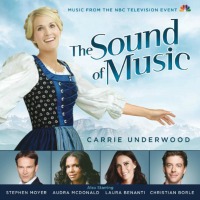 Television Cast, 2014 (Sony Masterworks )
Television Cast, 2014 (Sony Masterworks )  (3 / 5) This is a fresh and largely wonderful new recording of a classic score. Carrie Underwood leads the cast as a Maria Von Trapp for the new century. Although her acting skills in the live television presentation left much to be desired, her musical performance is very sweet on its own Country/Western terms. Audra McDonald sings beautifully as the Mother Abbess, even if she doesn’t posses the type of mezzo/contralto voice usually associated with the role. As Elsa and Max, Laura Benanti and Christian Borle are both excellent. Stephen Moyer is no more than adequate as Captain Von Trapp, but all the children and the nuns’ chorus are nearly as good as those heard on the finest of the other recordings. Overall, this performance breathes new life into songs that have become almost too familiar because they are so beloved. It’s a testament to Rodgers and Hammerstein that the score of The Sound of Music can be interpreted in so many different ways, even sometimes by actors who are miscast, and still come shining through. — G.A.
(3 / 5) This is a fresh and largely wonderful new recording of a classic score. Carrie Underwood leads the cast as a Maria Von Trapp for the new century. Although her acting skills in the live television presentation left much to be desired, her musical performance is very sweet on its own Country/Western terms. Audra McDonald sings beautifully as the Mother Abbess, even if she doesn’t posses the type of mezzo/contralto voice usually associated with the role. As Elsa and Max, Laura Benanti and Christian Borle are both excellent. Stephen Moyer is no more than adequate as Captain Von Trapp, but all the children and the nuns’ chorus are nearly as good as those heard on the finest of the other recordings. Overall, this performance breathes new life into songs that have become almost too familiar because they are so beloved. It’s a testament to Rodgers and Hammerstein that the score of The Sound of Music can be interpreted in so many different ways, even sometimes by actors who are miscast, and still come shining through. — G.A.
Sophisticated Ladies
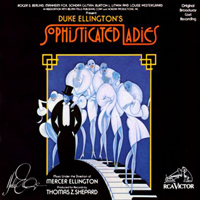 Original Broadway Cast, 1981 (RCA)
Original Broadway Cast, 1981 (RCA)  (3 / 5) Duke Ellington classics were well served in the revue Sophisticated Ladies, which received 10 Tony Award nominations and ran on Broadway for nearly two years. Without the show’s visual elements, the recording sounds more like a greatest-hits anthology featuring the Duke Ellington Orchestra and fine singers than a traditional cast album, but Ellington’s genius as a composer is amply evident in the staggering array of wonderful songs to be found here: “It Don’t Mean a Thing,” “Don’t Get Around Much Anymore,” “Take the A Train,” “I Let a Song Go Out of My Heart,” “Satin Doll,” “Mood Indigo,” “I Got It Bad and That Ain’t Good,” “I’m Beginning to See the Light” — and, of course, “Sophisticated Lady.” Cast members Gregory Hines, Judith Jamison, Phyllis Hyman, P.J. Benjamin, Gregg Burge, and Hinton Battle are all top-notch, as is the musical direction by Mercer Ellington. — Morgan Sills
(3 / 5) Duke Ellington classics were well served in the revue Sophisticated Ladies, which received 10 Tony Award nominations and ran on Broadway for nearly two years. Without the show’s visual elements, the recording sounds more like a greatest-hits anthology featuring the Duke Ellington Orchestra and fine singers than a traditional cast album, but Ellington’s genius as a composer is amply evident in the staggering array of wonderful songs to be found here: “It Don’t Mean a Thing,” “Don’t Get Around Much Anymore,” “Take the A Train,” “I Let a Song Go Out of My Heart,” “Satin Doll,” “Mood Indigo,” “I Got It Bad and That Ain’t Good,” “I’m Beginning to See the Light” — and, of course, “Sophisticated Lady.” Cast members Gregory Hines, Judith Jamison, Phyllis Hyman, P.J. Benjamin, Gregg Burge, and Hinton Battle are all top-notch, as is the musical direction by Mercer Ellington. — Morgan Sills
Songs for a New World
 Original Cast, 1997 (RCA)
Original Cast, 1997 (RCA)  (3 / 5) Songs for a New World documents composer-lyricist Jason Robert Brown’s superb musicianship and his knack for connecting with younger audiences who appreciate contemporary musical theater styles. Even though Brown’s occasional tendency toward self-indulgence in his work is apparent here, this recording of his inaugural revue makes it clear why he burst onto the New York theater scene in such a big way. As a creator of story songs, he’s a master, and some of his most brilliant work is heard on this album. Highlights include “Stars and the Moon” and the searingly funny Brecht/Weill parody “Surabaya Santa,” both expertly sung by Jessica Molaskey; ”I’m Not Afraid of Anything,” movingly delivered by Andrea Burns; and the modern love duet “I’d Give It All for You,” impressively performed by Burns and Brooks Ashmanskas. Ty Taylor, the fourth performer heard here, is somewhat lacking in spark. The singers, the band (led by Brown), and the orchestrations (by Brown and Doug Besterman) generally keep the songs sharp, but some of them have a similar, inflated sound that grows wearisome in large doses — notably, “The New World,” ”American Flag, 1775,” and “Hear My Song” (in which Brown sings). So, worthy as this recording is, it’s most enjoyable when sampled a little at a time. — Matthew Murray
(3 / 5) Songs for a New World documents composer-lyricist Jason Robert Brown’s superb musicianship and his knack for connecting with younger audiences who appreciate contemporary musical theater styles. Even though Brown’s occasional tendency toward self-indulgence in his work is apparent here, this recording of his inaugural revue makes it clear why he burst onto the New York theater scene in such a big way. As a creator of story songs, he’s a master, and some of his most brilliant work is heard on this album. Highlights include “Stars and the Moon” and the searingly funny Brecht/Weill parody “Surabaya Santa,” both expertly sung by Jessica Molaskey; ”I’m Not Afraid of Anything,” movingly delivered by Andrea Burns; and the modern love duet “I’d Give It All for You,” impressively performed by Burns and Brooks Ashmanskas. Ty Taylor, the fourth performer heard here, is somewhat lacking in spark. The singers, the band (led by Brown), and the orchestrations (by Brown and Doug Besterman) generally keep the songs sharp, but some of them have a similar, inflated sound that grows wearisome in large doses — notably, “The New World,” ”American Flag, 1775,” and “Hear My Song” (in which Brown sings). So, worthy as this recording is, it’s most enjoyable when sampled a little at a time. — Matthew Murray
Song of Singapore
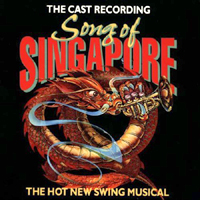 Original Off-Broadway Cast Members, 1992 (DRG)
Original Off-Broadway Cast Members, 1992 (DRG)  (2 / 5) A tongue-in-cheek pastiche of 1940s pop culture, Song of Singapore had a substantial Off-Broadway run at a nightclub venue. It was whipped up by a quartet of composer-performers: Erik Frandsen, Michael Garin, Robert Hipkens, and Paula Lockheart, who wrote the songs and collaborated on the book with Allan Katz. Set in a Singapore gin mill, the plot deals with a jewel heist, a murder, an amnesiac female flier who’s also a lounge singer, and a band called the Malayan Melody Makers. It includes elements of works by W. Somerset Maugham, Raymond Chandler, and numerous black-and-white movies. The songs work nicely within the context of the daffy libretto and benefit from first-rate execution by a five-person combo; further instrumentation is provided by the versatile cast. With tropical drinks flowing and table-seated spectators surrounded by dramatic action, Song of Singapore was a great night out, but no one’s idea of a landmark in musical theater. Still, the swinging score received Drama Desk and Outer Critics Circle citations and was preserved via this recording, which features the torchy Jacquey Maltby and three of the show’s songwriters. (The fourth, Lockheart, served as the production’s “jazzaturg.”) Donna Murphy, who was in the original cast, is not heard here. Director A. J. Antoon died during the show’s run, so Song of Singapore is fondly remembered by theater folk as his swan song. — Charles Wright
(2 / 5) A tongue-in-cheek pastiche of 1940s pop culture, Song of Singapore had a substantial Off-Broadway run at a nightclub venue. It was whipped up by a quartet of composer-performers: Erik Frandsen, Michael Garin, Robert Hipkens, and Paula Lockheart, who wrote the songs and collaborated on the book with Allan Katz. Set in a Singapore gin mill, the plot deals with a jewel heist, a murder, an amnesiac female flier who’s also a lounge singer, and a band called the Malayan Melody Makers. It includes elements of works by W. Somerset Maugham, Raymond Chandler, and numerous black-and-white movies. The songs work nicely within the context of the daffy libretto and benefit from first-rate execution by a five-person combo; further instrumentation is provided by the versatile cast. With tropical drinks flowing and table-seated spectators surrounded by dramatic action, Song of Singapore was a great night out, but no one’s idea of a landmark in musical theater. Still, the swinging score received Drama Desk and Outer Critics Circle citations and was preserved via this recording, which features the torchy Jacquey Maltby and three of the show’s songwriters. (The fourth, Lockheart, served as the production’s “jazzaturg.”) Donna Murphy, who was in the original cast, is not heard here. Director A. J. Antoon died during the show’s run, so Song of Singapore is fondly remembered by theater folk as his swan song. — Charles Wright
Song of Norway
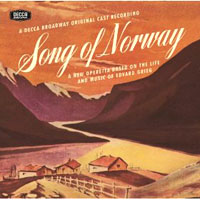 Original Broadway Cast Members, 1944 (Decca)
Original Broadway Cast Members, 1944 (Decca)  (4 / 5) “Hurry, Countess! The boys’ names are in the cakes! They’re starting the drawing!” So runs a typical line of dialogue in this peerlessly fruity operetta that’s supposedly based on the life of composer Edvard Grieg. Song of Norway was a smash hit and an auspicious Broadway debut for musical adapters and lyricists Robert Wright and George Forrest. The fanciful plot — Grieg loves Nina but is intercepted by a temperamental diva, escapes her clutches and writes the A Minor Concerto — hasn’t an original moment in it. The original production featured super singers, and this cast album, with its generous song-scenes and purple dialogue, certainly is an earful. Lawrence Brooks and Helena Bliss are appealing in the leads, even if, after yodeling the hit ballad “Strange Music,” Brooks has to rhapsodize: “Oh, Darling, to think we’ve just found each other!” And tenor Robert Shafer, as their poet comrade Nordraak, is spectacular. The role of the vexing diva Louisa Giovanni, played on Broadway by Irra Petina, is sung here by Decca’s house soprano, Kitty Carlisle. Although she doesn’t possess a magnificent voice, Carlisle dives head-first into the ridiculous text, and her classic vocal performance is something to treasure. — Marc Miller
(4 / 5) “Hurry, Countess! The boys’ names are in the cakes! They’re starting the drawing!” So runs a typical line of dialogue in this peerlessly fruity operetta that’s supposedly based on the life of composer Edvard Grieg. Song of Norway was a smash hit and an auspicious Broadway debut for musical adapters and lyricists Robert Wright and George Forrest. The fanciful plot — Grieg loves Nina but is intercepted by a temperamental diva, escapes her clutches and writes the A Minor Concerto — hasn’t an original moment in it. The original production featured super singers, and this cast album, with its generous song-scenes and purple dialogue, certainly is an earful. Lawrence Brooks and Helena Bliss are appealing in the leads, even if, after yodeling the hit ballad “Strange Music,” Brooks has to rhapsodize: “Oh, Darling, to think we’ve just found each other!” And tenor Robert Shafer, as their poet comrade Nordraak, is spectacular. The role of the vexing diva Louisa Giovanni, played on Broadway by Irra Petina, is sung here by Decca’s house soprano, Kitty Carlisle. Although she doesn’t possess a magnificent voice, Carlisle dives head-first into the ridiculous text, and her classic vocal performance is something to treasure. — Marc Miller
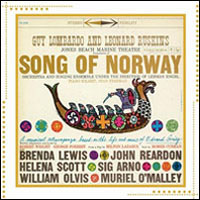 Jones Beach Marine Theatre Cast, 1959 (Columbia/Masterworks Broadway-Arkivmusic)
Jones Beach Marine Theatre Cast, 1959 (Columbia/Masterworks Broadway-Arkivmusic)  (3 / 5) Brenda Lewis is a trouper of a Louisa here, savoring her character’s temperament and attacking her high notes with mastery. Unfortunately, this cast album of a successful Song of Norway summer production — “One of the largest and costliest musicals ever presented on the living stage,” the liner notes crow — stints on the ripe operetta dialogue, so we’re left with a fairly straightforward presentation of material that shouldn’t have its silliness masked. The recording also omits some of the show’s most charming musical moments (“Midsummer Eve,” “At Christmastime”) to make room for the entire Piano Concerto in A Minor. Still, as conducted by Lehman Engel and backed by a chorus of 200, it’s a pretty grand performance. John Reardon is a rich-voiced Grieg, Helena Scott a pretty but brain-dead Nina. Sig Arno, a veteran of the original Broadway cast, still purrs ably through “Bon Vivant.” And, as Nordraak, William Olvis has a vibrato that could drill through cement. — M.M.
(3 / 5) Brenda Lewis is a trouper of a Louisa here, savoring her character’s temperament and attacking her high notes with mastery. Unfortunately, this cast album of a successful Song of Norway summer production — “One of the largest and costliest musicals ever presented on the living stage,” the liner notes crow — stints on the ripe operetta dialogue, so we’re left with a fairly straightforward presentation of material that shouldn’t have its silliness masked. The recording also omits some of the show’s most charming musical moments (“Midsummer Eve,” “At Christmastime”) to make room for the entire Piano Concerto in A Minor. Still, as conducted by Lehman Engel and backed by a chorus of 200, it’s a pretty grand performance. John Reardon is a rich-voiced Grieg, Helena Scott a pretty but brain-dead Nina. Sig Arno, a veteran of the original Broadway cast, still purrs ably through “Bon Vivant.” And, as Nordraak, William Olvis has a vibrato that could drill through cement. — M.M.
 Studio Cast, 1961 (Angel/no CD)
Studio Cast, 1961 (Angel/no CD)  (3 / 5) Norman Newell had a nice run producing British stage musical cast recordings as well as many pop hits, and he also ventured occasionally into studio cast albums. This Norway is lushly recorded in early-’60s stereo. Michael Collins leads an orchestra much larger than any pit orchestra, but Collins does allow the tempi to drag fearfully in the waltzes. John Lawrenson is a sturdy Grieg, Norma Hughes a charming Nina, and if Thomas Round’s Nordraak doesn’t achieve the ringing high notes of Robert Shafer in the original, he declaims the silly Wright/Forrest lyrics with conviction. As Louisa, the strong-voiced Victoria Elliott, deprived of all the purple dialogue that Kitty Carlisle relishes on the original recording, makes less of an impression. A couple of songs are excluded, and one misses Sig Arno chewing his consonants through “Bon Vivant.” The album ends with a much fuller version of the Piano Concerto in A Minor than is heard on the Broadway cast album; Alberto Semprini, here billed simply as “Semprini,” is the soloist. This LP is not easy to find and probably not worth searching for, but if you do happen to see it in a bin at a used record store, you might want to snap it up. — M.M.
(3 / 5) Norman Newell had a nice run producing British stage musical cast recordings as well as many pop hits, and he also ventured occasionally into studio cast albums. This Norway is lushly recorded in early-’60s stereo. Michael Collins leads an orchestra much larger than any pit orchestra, but Collins does allow the tempi to drag fearfully in the waltzes. John Lawrenson is a sturdy Grieg, Norma Hughes a charming Nina, and if Thomas Round’s Nordraak doesn’t achieve the ringing high notes of Robert Shafer in the original, he declaims the silly Wright/Forrest lyrics with conviction. As Louisa, the strong-voiced Victoria Elliott, deprived of all the purple dialogue that Kitty Carlisle relishes on the original recording, makes less of an impression. A couple of songs are excluded, and one misses Sig Arno chewing his consonants through “Bon Vivant.” The album ends with a much fuller version of the Piano Concerto in A Minor than is heard on the Broadway cast album; Alberto Semprini, here billed simply as “Semprini,” is the soloist. This LP is not easy to find and probably not worth searching for, but if you do happen to see it in a bin at a used record store, you might want to snap it up. — M.M.
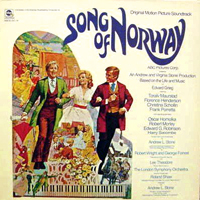 Film Soundtrack, 1970 (ABC/no CD)
Film Soundtrack, 1970 (ABC/no CD)  (2 / 5) The cinematic success of The Sound of Music inspired a parade of family-friendly movie musicals, but none followed the climb-ev’ry-mountain template as closely as this one. It features hillsides, streams, and Florence Henderson standing in for Julie Andrews. While the film itself is an atrocity, the soundtrack, surprisingly, is not. Grieg is Grieg, after all, and his music is played here by the London Symphony. The film retains just a few songs from the stage version; Wright and Forrest raided the Grieg catalog further and set others of his melodies to florid but not unintelligent lyrics. Toralv Maurstad as Grieg has very little voice, so most of the male vocals are assigned to Frank Porretta, a fine singer who nevertheless strains as the notes sail high above the staff. Fortunately, Harry Secombe steps in for three tracks, his ringing tenor as thrilling as ever. Henderson is her usual competent, unexciting self, though unexpectedly affecting in “The Little House” and “Wrong to Dream.” Roland Shaw is the very busy musical supervisor. — M.M.
(2 / 5) The cinematic success of The Sound of Music inspired a parade of family-friendly movie musicals, but none followed the climb-ev’ry-mountain template as closely as this one. It features hillsides, streams, and Florence Henderson standing in for Julie Andrews. While the film itself is an atrocity, the soundtrack, surprisingly, is not. Grieg is Grieg, after all, and his music is played here by the London Symphony. The film retains just a few songs from the stage version; Wright and Forrest raided the Grieg catalog further and set others of his melodies to florid but not unintelligent lyrics. Toralv Maurstad as Grieg has very little voice, so most of the male vocals are assigned to Frank Porretta, a fine singer who nevertheless strains as the notes sail high above the staff. Fortunately, Harry Secombe steps in for three tracks, his ringing tenor as thrilling as ever. Henderson is her usual competent, unexciting self, though unexpectedly affecting in “The Little House” and “Wrong to Dream.” Roland Shaw is the very busy musical supervisor. — M.M.
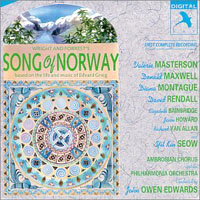 Studio Cast, 1990 (JAY, 2CDs)
Studio Cast, 1990 (JAY, 2CDs)  (3 / 5) Spreading Song of Norway over two CDs has its advantages: more Grieg (with a smattering of Verdi in a Traviata excerpt), more imperishable dialogue, and more complete song scenes. The Act I finale, for instance, builds and builds before fading into a satisfying pianissimo. But John Owen Edwards’ conducting is slightly stolid, and the overall performance style is more dutiful than inspired. As compared with the cast of the 1944 recording, the singers heard here don’t have the sort of natural artificiality that’s required. Diana Montague comes close as Louisa, her killer soprano hitting the right notes of haughtiness. But Donald Maxwell’s chirpy Grieg sounds like a first reading; David Rendall’s Nordraak is resonant but flat-out boring; and the usually reliable Valerie Masterson is a so-so Nina, shrill in her upper register. Concert pianist Yit Kin Seow plunges avidly into the concerto, and Wright and Forrest contribute an informative if self-serving essay to the accompanying booklet. — M.M.
(3 / 5) Spreading Song of Norway over two CDs has its advantages: more Grieg (with a smattering of Verdi in a Traviata excerpt), more imperishable dialogue, and more complete song scenes. The Act I finale, for instance, builds and builds before fading into a satisfying pianissimo. But John Owen Edwards’ conducting is slightly stolid, and the overall performance style is more dutiful than inspired. As compared with the cast of the 1944 recording, the singers heard here don’t have the sort of natural artificiality that’s required. Diana Montague comes close as Louisa, her killer soprano hitting the right notes of haughtiness. But Donald Maxwell’s chirpy Grieg sounds like a first reading; David Rendall’s Nordraak is resonant but flat-out boring; and the usually reliable Valerie Masterson is a so-so Nina, shrill in her upper register. Concert pianist Yit Kin Seow plunges avidly into the concerto, and Wright and Forrest contribute an informative if self-serving essay to the accompanying booklet. — M.M.
Songbook
 Original London Cast, 1979 (Pye/DRG)
Original London Cast, 1979 (Pye/DRG)  (3 / 5) The centerpiece of this show, a revue of songs written by a fictional Irish-Jewish composer named Moony Shapiro, is a seven-minute medley of “vocal gems” supposedly drawn from Shapiro’s one, long-ago Broadway hit. It’s silly, but it works, and much the same can be said for the rest of Songbook. With music by Monty Norman and lyrics by Julian More, these songs are affectionate, clever pastiche. The result is genial fun, expertly performed. Particularly good are the Gershwin spoof “East River Rhapsody,” the Spike Jones-ish “Nazi Party Pooper,” the terrific ballad “Messages,” and everything sung by Diane Langton. (Note: Under the title The Moony Shapiro Songbook, this show had a one-performance Broadway run in 1981, in a production that featured Judy Kaye, Jeff Goldblum, Tim Jerome, and Gary Beach.) — Seth Christenfeld
(3 / 5) The centerpiece of this show, a revue of songs written by a fictional Irish-Jewish composer named Moony Shapiro, is a seven-minute medley of “vocal gems” supposedly drawn from Shapiro’s one, long-ago Broadway hit. It’s silly, but it works, and much the same can be said for the rest of Songbook. With music by Monty Norman and lyrics by Julian More, these songs are affectionate, clever pastiche. The result is genial fun, expertly performed. Particularly good are the Gershwin spoof “East River Rhapsody,” the Spike Jones-ish “Nazi Party Pooper,” the terrific ballad “Messages,” and everything sung by Diane Langton. (Note: Under the title The Moony Shapiro Songbook, this show had a one-performance Broadway run in 1981, in a production that featured Judy Kaye, Jeff Goldblum, Tim Jerome, and Gary Beach.) — Seth Christenfeld
Song & Dance
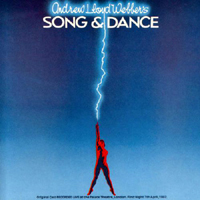 Original London Cast, 1982 (Really Useful Records, 2CDs)
Original London Cast, 1982 (Really Useful Records, 2CDs)  (2 / 5) This two-disc album was recorded live during the show’s opening-night performance, and it has a definite theatrical snap to it. Song & Dance is a unique show comprised of two very different parts — a one-woman song cycle and a ballet — that are only tangentially related. The first act, subtitled “Tell Me on a Sunday” after the best song in the score, concerns Emma, an English girl who goes to New York seeking a career as a hat designer. During her one-hour musical monologue, Marti Webb as Emma makes wry observations about life and men in Manhattan — sometimes expressed through letters written home to her mum, sometimes directly addressed to her unseen boyfriends. With music by Andrew Lloyd Webber and lyrics by Don Black, the Song score has two fine ballads in “Tell Me on a Sunday” and “The Last Man in My Life.” Also affecting is the angry, sarcastic “Take That Look Off Your Face.” Some of the other music sounds like filler, but the lyrics are generally fine, delivered by Webb with conviction. The second half of Song & Dance is subtitled “Variations.” However entertaining the dance may have been onstage, hearing this music on a recording is not quite the same experience as listening to ballet music by Tchaikovsky or Prokofiev. “Unexpected Song” is the most memorable melody in the ballet score, and “Variation 8” is also nice. — Michael Portantiere
(2 / 5) This two-disc album was recorded live during the show’s opening-night performance, and it has a definite theatrical snap to it. Song & Dance is a unique show comprised of two very different parts — a one-woman song cycle and a ballet — that are only tangentially related. The first act, subtitled “Tell Me on a Sunday” after the best song in the score, concerns Emma, an English girl who goes to New York seeking a career as a hat designer. During her one-hour musical monologue, Marti Webb as Emma makes wry observations about life and men in Manhattan — sometimes expressed through letters written home to her mum, sometimes directly addressed to her unseen boyfriends. With music by Andrew Lloyd Webber and lyrics by Don Black, the Song score has two fine ballads in “Tell Me on a Sunday” and “The Last Man in My Life.” Also affecting is the angry, sarcastic “Take That Look Off Your Face.” Some of the other music sounds like filler, but the lyrics are generally fine, delivered by Webb with conviction. The second half of Song & Dance is subtitled “Variations.” However entertaining the dance may have been onstage, hearing this music on a recording is not quite the same experience as listening to ballet music by Tchaikovsky or Prokofiev. “Unexpected Song” is the most memorable melody in the ballet score, and “Variation 8” is also nice. — Michael Portantiere
 Original Broadway Cast, 1985 (RCA)
Original Broadway Cast, 1985 (RCA)  (3 / 5) This album preserves only the songs of Song & Dance. The musical monologue was revised for Broadway by Richard Maltby, Jr., who directed the show and adapted and added lyrics. In this version, we hear about Emma’s involvement with four different men, most significantly a guy named Joe. In a major addition to the score, Emma sings the beautiful “Unexpected Song,” to a melody originally written for the ballet section of the score, upon falling in love with Joe. The music is so lovely, and the lyrics so well crafted, that this track is the definite highlight of the album. “Nothing Like You I’ve Ever Known” from the London version is also included here, even though it wasn’t in the Broadway show. Bernadette Peters’ British accent as Emma sometimes sounds natural, sometimes studied, but the star is in fine voice, and her performance is sympathetic throughout. On the minus side, the orchestrations sound cheesy, perhaps because they are so poorly recorded and mixed. There’s also some audio distortion of Peters’ voice in “English Girls.” — M.P.
(3 / 5) This album preserves only the songs of Song & Dance. The musical monologue was revised for Broadway by Richard Maltby, Jr., who directed the show and adapted and added lyrics. In this version, we hear about Emma’s involvement with four different men, most significantly a guy named Joe. In a major addition to the score, Emma sings the beautiful “Unexpected Song,” to a melody originally written for the ballet section of the score, upon falling in love with Joe. The music is so lovely, and the lyrics so well crafted, that this track is the definite highlight of the album. “Nothing Like You I’ve Ever Known” from the London version is also included here, even though it wasn’t in the Broadway show. Bernadette Peters’ British accent as Emma sometimes sounds natural, sometimes studied, but the star is in fine voice, and her performance is sympathetic throughout. On the minus side, the orchestrations sound cheesy, perhaps because they are so poorly recorded and mixed. There’s also some audio distortion of Peters’ voice in “English Girls.” — M.P.
Something for the Boys
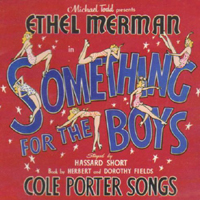 Ethel Merman and Original Cast Members, c. 1944 (AEI)
Ethel Merman and Original Cast Members, c. 1944 (AEI)  (3 / 5) Perhaps the definitive wartime musical, Something for the Boys was a hit for Cole Porter and Ethel Merman. It offers an enjoyable score, but not a major one. (Forget the book, the plot of which climaxes when the Merman character, Blossom Hart, discovers that her dental work can intercept Axis radio messages.) You keep hearing echoes of earlier, better Porter in some of the songs: “He’s a Right Guy,” for instance, bears more than a passing resemblance to “I Get a Kick Out of You.” “By the Mississinewah” isn’t clever enough to overcome its jarring political incorrectness; it might have been funny to watch Merman and Paula Laurence schlep through a faux-squaw routine, but the song itself doesn’t cut it. Although the notes don’t say so, these tracks were drawn from two radio broadcasts: Merman sings “I’m in Love With a Soldier Boy,” which had been sung by Betty Garrett onstage, and Laurence has been replaced in Chiquita Hart’s numbers by Betty Bruce, who was also in the original cast. But the recording does give us Merman in her star-spangled prime, plus the excellent Bill Johnson as her romantic interest. — Richard Barrios
(3 / 5) Perhaps the definitive wartime musical, Something for the Boys was a hit for Cole Porter and Ethel Merman. It offers an enjoyable score, but not a major one. (Forget the book, the plot of which climaxes when the Merman character, Blossom Hart, discovers that her dental work can intercept Axis radio messages.) You keep hearing echoes of earlier, better Porter in some of the songs: “He’s a Right Guy,” for instance, bears more than a passing resemblance to “I Get a Kick Out of You.” “By the Mississinewah” isn’t clever enough to overcome its jarring political incorrectness; it might have been funny to watch Merman and Paula Laurence schlep through a faux-squaw routine, but the song itself doesn’t cut it. Although the notes don’t say so, these tracks were drawn from two radio broadcasts: Merman sings “I’m in Love With a Soldier Boy,” which had been sung by Betty Garrett onstage, and Laurence has been replaced in Chiquita Hart’s numbers by Betty Bruce, who was also in the original cast. But the recording does give us Merman in her star-spangled prime, plus the excellent Bill Johnson as her romantic interest. — Richard Barrios
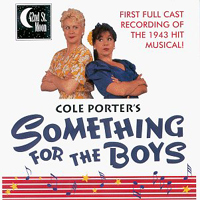 San Francisco Cast, 1997 (Music Box)
San Francisco Cast, 1997 (Music Box)  (2 / 5) Even a second-rate work by a master such as Cole Porter is worth knowing, and Something for the Boys hasn’t been entirely neglected in later years. Several small-scale revivals have been staged. San Francisco’s intrepid 42nd St. Moon company’s production prompted this complete recording, with piano accompaniment. This show was never intended to be a piece for the ages; it’s theatrical junk food that’s pretty tasty and not wholly without nutrition. But it does require a pair of star voices, and here the San Franciscans come up somewhat short: Meg Mackay and Joseph Lustig are engaging, but the score needs more. At least the “Mississinewah” number, as performed by Mackay and LesleyHamilton, has some o fthe bawdy sheen that must have caused folks to cheer back in 1943. — R.B.
(2 / 5) Even a second-rate work by a master such as Cole Porter is worth knowing, and Something for the Boys hasn’t been entirely neglected in later years. Several small-scale revivals have been staged. San Francisco’s intrepid 42nd St. Moon company’s production prompted this complete recording, with piano accompaniment. This show was never intended to be a piece for the ages; it’s theatrical junk food that’s pretty tasty and not wholly without nutrition. But it does require a pair of star voices, and here the San Franciscans come up somewhat short: Meg Mackay and Joseph Lustig are engaging, but the score needs more. At least the “Mississinewah” number, as performed by Mackay and LesleyHamilton, has some o fthe bawdy sheen that must have caused folks to cheer back in 1943. — R.B.
 Studio Cast, 2018 (PS Classics)
Studio Cast, 2018 (PS Classics)  (2 / 5) With this note-complete recording, Something for the Boys receives a treatment denied to a number of other Cole Porter shows, the superior Jubilee in particular. No doubt about it, Porter’s rowdy wartime score has been treated with loving care by everyone at PS Classics, and they even threw in a marching band! It has to be reported, however, that the show might have benefited from a little less love and a little more dirt. The entire performance is correct and entertaining, most certainly — but a quick listen to some of those original cast recordings will show what’s needed and what’s missing. This is nowhere more apparent than with Elizabeth Stanley, a clear-voiced non-belter cast in the Merman role. While her dialogue is a little closer to the mark, it all sounds more gracious than boisterous, which isn’t the right approach. (Stanley as Blossom Hart is reminiscent of Ann Sothern taking over for Merman as Panama Hattie.) Danny Burstein is sturdy as always, the rest of the cast is completely competent, and there are indeed moments when the 1944 swing-and-brass come through. Still, like Ms. Stanley, it’s all too smooth, even dainty, for this kind of material. — R.B.
(2 / 5) With this note-complete recording, Something for the Boys receives a treatment denied to a number of other Cole Porter shows, the superior Jubilee in particular. No doubt about it, Porter’s rowdy wartime score has been treated with loving care by everyone at PS Classics, and they even threw in a marching band! It has to be reported, however, that the show might have benefited from a little less love and a little more dirt. The entire performance is correct and entertaining, most certainly — but a quick listen to some of those original cast recordings will show what’s needed and what’s missing. This is nowhere more apparent than with Elizabeth Stanley, a clear-voiced non-belter cast in the Merman role. While her dialogue is a little closer to the mark, it all sounds more gracious than boisterous, which isn’t the right approach. (Stanley as Blossom Hart is reminiscent of Ann Sothern taking over for Merman as Panama Hattie.) Danny Burstein is sturdy as always, the rest of the cast is completely competent, and there are indeed moments when the 1944 swing-and-brass come through. Still, like Ms. Stanley, it’s all too smooth, even dainty, for this kind of material. — R.B.
Some Like It Hot
 Original London Cast, 1992 (First Night) No stars; not recommended. Twenty years after the musical Sugar played on Broadway, this revised, retitled version showed up in London. Judging from the cast album, Tommy Steele, who directed and starred in the show, made some peculiar decisions — not the least of which was playing the wrong part. Instead of taking the role of Daphne (Robert Morse on Broadway, Jack Lemmon in the classic 1959 film Some Like It Hot), he opted for the romantic Tony Roberts/Tony Curtis part. Unfortunately, this character has the dullest material in the musical. Yet Steele is all over the recording, while Daphne and Sugar (the Marilyn Monroe character) have very few songs. The Jule Styne-Bob Merrill score has been treated cavalierly; for instance, the opening number is now Scott Joplin’s (uncredited) “Maple Leaf Rag.” Several songs have been cut, some have been combined with others, lyrics have been rewritten throughout, and there are odd interpolations. “I’m Naive,” a fine song from a Styne-Merrill TV musical, has been inappropriately handed to Sugar. Worse, the amusing “November Song” from Sugar has been replaced by “Dirty Old Men,” with music and lyrics by Merrill, originally written for Breakfast at Tiffany’s. There’s also an uncredited title song. — David Wolf
Original London Cast, 1992 (First Night) No stars; not recommended. Twenty years after the musical Sugar played on Broadway, this revised, retitled version showed up in London. Judging from the cast album, Tommy Steele, who directed and starred in the show, made some peculiar decisions — not the least of which was playing the wrong part. Instead of taking the role of Daphne (Robert Morse on Broadway, Jack Lemmon in the classic 1959 film Some Like It Hot), he opted for the romantic Tony Roberts/Tony Curtis part. Unfortunately, this character has the dullest material in the musical. Yet Steele is all over the recording, while Daphne and Sugar (the Marilyn Monroe character) have very few songs. The Jule Styne-Bob Merrill score has been treated cavalierly; for instance, the opening number is now Scott Joplin’s (uncredited) “Maple Leaf Rag.” Several songs have been cut, some have been combined with others, lyrics have been rewritten throughout, and there are odd interpolations. “I’m Naive,” a fine song from a Styne-Merrill TV musical, has been inappropriately handed to Sugar. Worse, the amusing “November Song” from Sugar has been replaced by “Dirty Old Men,” with music and lyrics by Merrill, originally written for Breakfast at Tiffany’s. There’s also an uncredited title song. — David Wolf
So Long, 174th Street
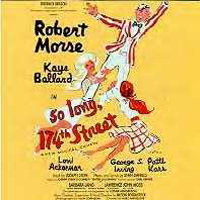 Studio Cast, 1980 (Original Cast Records)
Studio Cast, 1980 (Original Cast Records)  (3 / 5) Joseph Stein adapted his backstage comedy Enter Laughing, based on a novel by Carl Reiner, into a musical that had a dismal two-week run in 1976 but was recorded four years later with many of the original company members. Middle-aged Robert Morse is miscast in the central role of David Kolowitz, an 18-year-old Bronx boy who dreams of Broadway stardom. The show focuses heavily on the kid’s fantasy life, especially his dreams of fame and sex; “I’m Undressing Girls With My Eyes,” he confesses at one point. The best numbers include “You,” a duet made up entirely of lines from 1930s pop songs (“There’s a small hotel / Where you can do-do that voodoo you do so well”); “Bolero on Rye,” an imagined romantic encounter at a deli; and “Men,” a showstopper in which Loni Ackerman, as David’s girlfriend, torchily recalls her former flames. George S. Irving, playing the seedy actor who mentors David, delivers the score’s most notorious number, “The Butler’s Song.” A fantasy sequence of David as a Hollywood stud, it begins with the lines “He’s screwing Dolores Del Rio / That’s why he cannot speak to you,” and continues with “At 5:30 he humps Alice Faye / Then Jean Harlow at seven / Mae West at eleven / And, somewhere between them, Fay Wray.” As David’s mom, Kaye Ballard belts out “If You Want to Break Your Mother’s Heart.” Stan Daniels’ tunes are catchy, if a bit derivative, and his lyrics are full of good humor about Jewish families and adolescent angst. — David Barbour
(3 / 5) Joseph Stein adapted his backstage comedy Enter Laughing, based on a novel by Carl Reiner, into a musical that had a dismal two-week run in 1976 but was recorded four years later with many of the original company members. Middle-aged Robert Morse is miscast in the central role of David Kolowitz, an 18-year-old Bronx boy who dreams of Broadway stardom. The show focuses heavily on the kid’s fantasy life, especially his dreams of fame and sex; “I’m Undressing Girls With My Eyes,” he confesses at one point. The best numbers include “You,” a duet made up entirely of lines from 1930s pop songs (“There’s a small hotel / Where you can do-do that voodoo you do so well”); “Bolero on Rye,” an imagined romantic encounter at a deli; and “Men,” a showstopper in which Loni Ackerman, as David’s girlfriend, torchily recalls her former flames. George S. Irving, playing the seedy actor who mentors David, delivers the score’s most notorious number, “The Butler’s Song.” A fantasy sequence of David as a Hollywood stud, it begins with the lines “He’s screwing Dolores Del Rio / That’s why he cannot speak to you,” and continues with “At 5:30 he humps Alice Faye / Then Jean Harlow at seven / Mae West at eleven / And, somewhere between them, Fay Wray.” As David’s mom, Kaye Ballard belts out “If You Want to Break Your Mother’s Heart.” Stan Daniels’ tunes are catchy, if a bit derivative, and his lyrics are full of good humor about Jewish families and adolescent angst. — David Barbour
Snoopy!!!
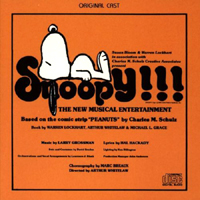 Original San Francisco Cast, 1976 (DRG)
Original San Francisco Cast, 1976 (DRG)  (2 / 5) If you admire You’re a Good Man, Charlie Brown as much as I do, you too may have trouble warming to its sequel, Snoopy!!! While the former captures Charles Schulz’s comic-strip characters well in all of their endearing idiosyncracies and obsessions, the problem with Snoopy!!! (aside from those exclamation points) is that its songs are generic. The most appealing number, “Poor Sweet Baby,” inspired by an actual Peanuts punch line, sounds like a pop song; “Don’t Be Anything Less Than Everything You Can Be” and “Just One Person” could have come from any children’s musical; and Snoopy’s 11-o’clock number, “The Big Bow Wow,” is empty showbiz. It doesn’t help that the bland Peppermint Patty is emphasized here as a substitute for the more dynamic character of Lucy. Lyricist Hal Hackady does connect with the comic strip successfully in “Clouds,” where the kids talk about the shapes they see in the sky — one sees the ceiling of the Sistine Chapel, one sees the Fall of Rome, but Charlie Brown is forced to admit that what he sees is “a horsey and a ducky.” Larry Grossman’s music is melodic and filled with humor, and the fine cast includes Don Potter, James Gleason, Pamela Myers, Jimmy Dodge, Carla Manning, Roxann Pyle, and Alfred Mazza. — David Wolf
(2 / 5) If you admire You’re a Good Man, Charlie Brown as much as I do, you too may have trouble warming to its sequel, Snoopy!!! While the former captures Charles Schulz’s comic-strip characters well in all of their endearing idiosyncracies and obsessions, the problem with Snoopy!!! (aside from those exclamation points) is that its songs are generic. The most appealing number, “Poor Sweet Baby,” inspired by an actual Peanuts punch line, sounds like a pop song; “Don’t Be Anything Less Than Everything You Can Be” and “Just One Person” could have come from any children’s musical; and Snoopy’s 11-o’clock number, “The Big Bow Wow,” is empty showbiz. It doesn’t help that the bland Peppermint Patty is emphasized here as a substitute for the more dynamic character of Lucy. Lyricist Hal Hackady does connect with the comic strip successfully in “Clouds,” where the kids talk about the shapes they see in the sky — one sees the ceiling of the Sistine Chapel, one sees the Fall of Rome, but Charlie Brown is forced to admit that what he sees is “a horsey and a ducky.” Larry Grossman’s music is melodic and filled with humor, and the fine cast includes Don Potter, James Gleason, Pamela Myers, Jimmy Dodge, Carla Manning, Roxann Pyle, and Alfred Mazza. — David Wolf
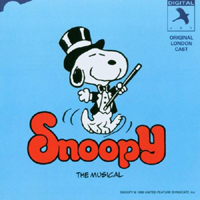 Original London Cast, 1983 (Polydor/JAY)
Original London Cast, 1983 (Polydor/JAY)  (3 / 5) Five songs not heard on the San Francisco recording are welcome additions here, and this version of Snoopy (those silly exclamation points having been removed for the London production) relates more specifically to the characters. “Snoopy’s Song” and “Mother’s Day” especially lift the Grossman-Hackady score, and although “Hurry Up, Face,” “Dime a Dozen,” and “When Do the Good Things Start?” aren’t as well targeted, they are so tuneful that we can forget about dramaturgy and simply enjoy the listening experience. Other improvements: Stuart Pedlar’s musical direction; a small instrumental combo, versus only two pianos on the first album; a fine overture; and, singing with far more spirit than their American counterparts, a terrific British cast consisting of Terry Kempner (Snoopy), Robert Locke (Charlie Brown), Nicky Croydon (Peppermint Patty), Susie Blake (Sally Brown), Mark Hadfield (Linus), Zoe Bright (Lucy), and Anthony Best (Woodstock). — D.W.
(3 / 5) Five songs not heard on the San Francisco recording are welcome additions here, and this version of Snoopy (those silly exclamation points having been removed for the London production) relates more specifically to the characters. “Snoopy’s Song” and “Mother’s Day” especially lift the Grossman-Hackady score, and although “Hurry Up, Face,” “Dime a Dozen,” and “When Do the Good Things Start?” aren’t as well targeted, they are so tuneful that we can forget about dramaturgy and simply enjoy the listening experience. Other improvements: Stuart Pedlar’s musical direction; a small instrumental combo, versus only two pianos on the first album; a fine overture; and, singing with far more spirit than their American counterparts, a terrific British cast consisting of Terry Kempner (Snoopy), Robert Locke (Charlie Brown), Nicky Croydon (Peppermint Patty), Susie Blake (Sally Brown), Mark Hadfield (Linus), Zoe Bright (Lucy), and Anthony Best (Woodstock). — D.W.
Smokey Joe’s Cafe
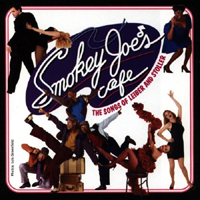 Original Broadway Cast, 1995 (Atlantic)
Original Broadway Cast, 1995 (Atlantic)  (2 / 5) Did Jerry Leiber and Mike Stoller write every great 1950s-’60s tune? That’s the feeling you get when listening to Smokey Joe’s Cafe, a greatest-hits revue of their songs that opened on Broadway in 1995 and ran for five years. “Spanish Harlem,” “Kansas City,” “I Who Have Nothing,” “Love Potion # 9,” ”I’m a Woman,” even novelty numbers like “Yakety Yak” and “Charlie Brown” are here, delivered by top-notch Broadway singer-dancers and backed by a Louis St. Louis-led band. Directed by Jerry Zaks, the production had a neon-hued party atmosphere that matched the pulsing, vintage-rock energy of the songs. On the recording, Ken Ard, Adrian Bailey, Victor Trent Cook (a tenor with a huge range), and Frederick B. Owens make a doo-wop group par excellence. Among the soloists, Pattie Darcy Jones has an appealing, slightly hoarse sound; B. ]. Crosby’s gospel growl is dynamite; and Brenda Braxton sizzles in everything she does. So why isn’t this album more fun? Probably because these are theatrical performers putting over the songs, not singers who live and die by their sound the way real rock ‘n’ roll shouters and thumpers do when they deliver a “Hound Dog” that will send you crawling to the pound. — Robert Sandla
(2 / 5) Did Jerry Leiber and Mike Stoller write every great 1950s-’60s tune? That’s the feeling you get when listening to Smokey Joe’s Cafe, a greatest-hits revue of their songs that opened on Broadway in 1995 and ran for five years. “Spanish Harlem,” “Kansas City,” “I Who Have Nothing,” “Love Potion # 9,” ”I’m a Woman,” even novelty numbers like “Yakety Yak” and “Charlie Brown” are here, delivered by top-notch Broadway singer-dancers and backed by a Louis St. Louis-led band. Directed by Jerry Zaks, the production had a neon-hued party atmosphere that matched the pulsing, vintage-rock energy of the songs. On the recording, Ken Ard, Adrian Bailey, Victor Trent Cook (a tenor with a huge range), and Frederick B. Owens make a doo-wop group par excellence. Among the soloists, Pattie Darcy Jones has an appealing, slightly hoarse sound; B. ]. Crosby’s gospel growl is dynamite; and Brenda Braxton sizzles in everything she does. So why isn’t this album more fun? Probably because these are theatrical performers putting over the songs, not singers who live and die by their sound the way real rock ‘n’ roll shouters and thumpers do when they deliver a “Hound Dog” that will send you crawling to the pound. — Robert Sandla
Skyscraper
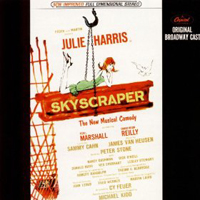 Original Broadway Cast, 1965 (Capitol/DRG) No stars; not recommended. With a book by Peter Stone, this musical is an adaptation of Elmer Rice’s Dream Girl. The show’s leading role was bestowed on a non-singing Broadway star, Julie Harris; she plays Georgina
Original Broadway Cast, 1965 (Capitol/DRG) No stars; not recommended. With a book by Peter Stone, this musical is an adaptation of Elmer Rice’s Dream Girl. The show’s leading role was bestowed on a non-singing Broadway star, Julie Harris; she plays Georgina
Allerton, the kooky owner of “The Litterbug” antiques shop, located in a Manhattan brownstone that stands in the way of a new skyscraper. Peter Marshall is the architect who romances her, and Charles Nelson Reilly is Harris’s assistant, who tries to sell her out. The songs, by composer James Van Heusen and lyricist Sammy Cahn, are worse than routine; the lyrics strain for cleverness, and Fred Werner’s metallic orchestrations overemphasize the clunky melodies. Among the oddities are “More Than One Way,” Marshall’s tribute to building ever-bigger skyscrapers; “Just the Crust,” the first of Reilly’s labored comedy numbers; “The Gaiety,” about rude delicatessen waiters; and “Haute Couture,” one of two weird songs sung by Rex Everhart as a construction foreman with his crew as they comment on unisex fashion trends: “You never know just who you may seduce / You think it’s Helen, but it might be Bruce!” Harris, croaking her way through her numbers, is no musical theater dreamgirl. — David Barbour
Sitting Pretty
 Studio Cast, 1990 (New World Records, 2CDs)
Studio Cast, 1990 (New World Records, 2CDs)  (3 / 5) Conductor John McGlinn is the one to thank for this recording of Sitting Pretty, a 1924 flop created by that legendary trio responsible for so many intimate, gentle musical comedies: composer Jerome Kern, librettist Guy Bolton, and lyricist P. G. Wodehouse. The plot, about orphaned twins mixing with the Long Island set, is a trifle; and the score, though easy to take, is overstuffed with what Lehman Engel would call “I want” songs, in which the characters wish that they were on a desert island, in a Congo paradise (several numbers in the show would give the P.C. police pause), or back in Sing-Sing. Wodehouse’s lyrics largely lack his usual curveballs: “A year from today, when I come back to you / The sun will be shining, the sky will be blue” must have sounded lame even in 1924. But there are some choice musical moments, courtesy of Kern, as when “The Enchanted Train” (a tribute to the Long Island Railroad) launches into a full-throttle orchestration, when “Shufflin’ Sam” quotes audaciously from the New World Symphony, and when “There Isn’t One Girl” takes some wild melodic leaps. The cast, led by Paige O’Hara and Judy Blazer, knows its stuff — O’Hara even delivers the lyrics in a slightly stilted fashion, as a 1920s vocalist might have done — and Roberta Peters drops in for a touching solo. The generous dialogue samplings reveal an uninteresting story, and the delivery is too cutesy by half. Still, this is an excellent recording, with bonus tracks. (An instrumental titled “All the World Is Dancing Mad” is irresistible). — Marc Miller
(3 / 5) Conductor John McGlinn is the one to thank for this recording of Sitting Pretty, a 1924 flop created by that legendary trio responsible for so many intimate, gentle musical comedies: composer Jerome Kern, librettist Guy Bolton, and lyricist P. G. Wodehouse. The plot, about orphaned twins mixing with the Long Island set, is a trifle; and the score, though easy to take, is overstuffed with what Lehman Engel would call “I want” songs, in which the characters wish that they were on a desert island, in a Congo paradise (several numbers in the show would give the P.C. police pause), or back in Sing-Sing. Wodehouse’s lyrics largely lack his usual curveballs: “A year from today, when I come back to you / The sun will be shining, the sky will be blue” must have sounded lame even in 1924. But there are some choice musical moments, courtesy of Kern, as when “The Enchanted Train” (a tribute to the Long Island Railroad) launches into a full-throttle orchestration, when “Shufflin’ Sam” quotes audaciously from the New World Symphony, and when “There Isn’t One Girl” takes some wild melodic leaps. The cast, led by Paige O’Hara and Judy Blazer, knows its stuff — O’Hara even delivers the lyrics in a slightly stilted fashion, as a 1920s vocalist might have done — and Roberta Peters drops in for a touching solo. The generous dialogue samplings reveal an uninteresting story, and the delivery is too cutesy by half. Still, this is an excellent recording, with bonus tracks. (An instrumental titled “All the World Is Dancing Mad” is irresistible). — Marc Miller
Sing Out, Sweet Land!
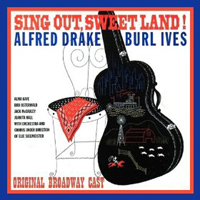 Original Broadway Cast, 1944 (Decca/Stage Door) No stars; not recommended. What’s more surprising: That this “salute to American folk and pop music” was produced on Broadway by The Theatre Guild, or that it managed a 13-week run? With no dramatic content at all, Sing Out, Sweet Land! was a sort of pageant celebrating country and folk music, an Elie Siegmaster compilation of songs that he had collected while traveling the country. Their authorship mostly unknown, the songs include well-known pieces like “Frankie and Johnnie,” “Big Rock Candy Mountain,” “Casey Jones,” and “The Blue-Tail Fly” (“Jimmy crack corn and I don’t care”), as well as others previously heard only in the Kentucky hills or sung by chain gangs — work songs, spirituals, and blues numbers. The show had a book and direction by Walter Kerr, who went on to a career as one of Broadway’s most respected drama critics. Alfred Drake and Burl Ives starred, and Bibi Osterwald, Juanita Hall, and Jack McCauley filled out the cast. But this recording is likely to be of little interest to musical theater enthusiasts, whose first response upon hearing “Jimmy crack corn” may be “I don’t care!” — David Wolf
Original Broadway Cast, 1944 (Decca/Stage Door) No stars; not recommended. What’s more surprising: That this “salute to American folk and pop music” was produced on Broadway by The Theatre Guild, or that it managed a 13-week run? With no dramatic content at all, Sing Out, Sweet Land! was a sort of pageant celebrating country and folk music, an Elie Siegmaster compilation of songs that he had collected while traveling the country. Their authorship mostly unknown, the songs include well-known pieces like “Frankie and Johnnie,” “Big Rock Candy Mountain,” “Casey Jones,” and “The Blue-Tail Fly” (“Jimmy crack corn and I don’t care”), as well as others previously heard only in the Kentucky hills or sung by chain gangs — work songs, spirituals, and blues numbers. The show had a book and direction by Walter Kerr, who went on to a career as one of Broadway’s most respected drama critics. Alfred Drake and Burl Ives starred, and Bibi Osterwald, Juanita Hall, and Jack McCauley filled out the cast. But this recording is likely to be of little interest to musical theater enthusiasts, whose first response upon hearing “Jimmy crack corn” may be “I don’t care!” — David Wolf
Singin’ in the Rain
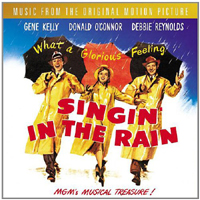 Film Soundtrack, 1952 (MGM/Rhino-Turner)
Film Soundtrack, 1952 (MGM/Rhino-Turner)  (5 / 5) For many, Singin’ in the Rain remains the greatest movie musical of all time. The mere image of Gene Kelly splashing around in those Hollywood puddles would be enough for some; for many others, the greatness of the film is that it’s one of the rare musicals, on stage or screen, that has a script (by Betty Comden and Adolph Green) equal in quality to its musical moments. If it isn’t possible to sock across the dialogue on a soundtrack album, two CD releases do a great job with the music. As part of its series of releases of MGM musical soundtrack recordings, Rhino-Turner did an excellent job with Singin’ in the Rain. A one-disc version gives us all of the songs plus a few extras; a two-disc set adds still more, including the original recordings of many of the wonderful old songs by Arthur Freed and Nacio Herb Brown that make up most of the film’s score. All of the movie tracks sound great, and it’s interesting to hear the underscoring without dialogue and sound effects. Another treat is listening in on material that didn’t make it to the final cut of the film: Debbie Reynolds’ rendition of “You Are My Lucky Star,” a “Dear Mr. Gable”-style apostrophe to a poster of Gene Kelly as Don Lockwood; Reynolds’ original attempt at “Would You?”, a song that was dubbed in the final film; and the original fashion-show narration for “Beautiful Girl.” — Richard Barrios
(5 / 5) For many, Singin’ in the Rain remains the greatest movie musical of all time. The mere image of Gene Kelly splashing around in those Hollywood puddles would be enough for some; for many others, the greatness of the film is that it’s one of the rare musicals, on stage or screen, that has a script (by Betty Comden and Adolph Green) equal in quality to its musical moments. If it isn’t possible to sock across the dialogue on a soundtrack album, two CD releases do a great job with the music. As part of its series of releases of MGM musical soundtrack recordings, Rhino-Turner did an excellent job with Singin’ in the Rain. A one-disc version gives us all of the songs plus a few extras; a two-disc set adds still more, including the original recordings of many of the wonderful old songs by Arthur Freed and Nacio Herb Brown that make up most of the film’s score. All of the movie tracks sound great, and it’s interesting to hear the underscoring without dialogue and sound effects. Another treat is listening in on material that didn’t make it to the final cut of the film: Debbie Reynolds’ rendition of “You Are My Lucky Star,” a “Dear Mr. Gable”-style apostrophe to a poster of Gene Kelly as Don Lockwood; Reynolds’ original attempt at “Would You?”, a song that was dubbed in the final film; and the original fashion-show narration for “Beautiful Girl.” — Richard Barrios
 Original London Cast, 1984 (First Night)
Original London Cast, 1984 (First Night)  (1 / 5) The greatness of Singin’ in the Rain — the movie, that is — was never more apparent than when it was adapted to the stage. First in London, then in the United States, people worked hard to do so: Both stage versions recreated most of the movie’s best-remembered moments in a script retooled by Comden and Green themselves, with some more songs and a lot of synthetic sparkle added. But it all fizzled out, because taking a movie musical about how movie musicals were invented and adapting it for the stage robs the story of its intimacy and what theorists call self-reflexivity. Plus, with those indelible movie performances firmly in all of our heads, who would be fool enough to try to copy Gene Kelly or Donald O’Connor? Tommy Steele sure would, at least in London. His energetic performance had a big smile pasted on everything, but little going on below the surface; although Steele is a better singer than Gene Kelly, his charm is synthetic. The rest of the cast works valiantly, but this recording stands as a splashy testimonial to the artistic bankruptcy of musical comedy in the 1980s. — R.B.
(1 / 5) The greatness of Singin’ in the Rain — the movie, that is — was never more apparent than when it was adapted to the stage. First in London, then in the United States, people worked hard to do so: Both stage versions recreated most of the movie’s best-remembered moments in a script retooled by Comden and Green themselves, with some more songs and a lot of synthetic sparkle added. But it all fizzled out, because taking a movie musical about how movie musicals were invented and adapting it for the stage robs the story of its intimacy and what theorists call self-reflexivity. Plus, with those indelible movie performances firmly in all of our heads, who would be fool enough to try to copy Gene Kelly or Donald O’Connor? Tommy Steele sure would, at least in London. His energetic performance had a big smile pasted on everything, but little going on below the surface; although Steele is a better singer than Gene Kelly, his charm is synthetic. The rest of the cast works valiantly, but this recording stands as a splashy testimonial to the artistic bankruptcy of musical comedy in the 1980s. — R.B.
 Studio Cast, 1996 (JAY)
Studio Cast, 1996 (JAY)  (1 / 5) Following the London staging of Singin’ in the Rain and the flop Broadway incarnation, there was an American tour and a few regional stagings. This recording is based on productions in Houston (Theatre Under the Stars) and New Jersey (Paper Mill Playhouse). It has a bit more heart and soul than the Tommy Steele thing, in part because it’s more successful at capturing the spirit of the original. Once again, however, the sound of the wonderful movie soundtrack simply could not be duplicated — not even under the baton of this recording’s talented and hard-working conductor, Craig Barna. The cast is-nearly faceless: Just listen to Michael Gruber delivering the “Dignity, always dignity” speech in the first scene, devoid of the charm, irony, and ego that Kelly brought to it. Finally, as in the Steele version, this effort washes out in trying to duplicate a 1950s version of a 1920s score. — R.B.
(1 / 5) Following the London staging of Singin’ in the Rain and the flop Broadway incarnation, there was an American tour and a few regional stagings. This recording is based on productions in Houston (Theatre Under the Stars) and New Jersey (Paper Mill Playhouse). It has a bit more heart and soul than the Tommy Steele thing, in part because it’s more successful at capturing the spirit of the original. Once again, however, the sound of the wonderful movie soundtrack simply could not be duplicated — not even under the baton of this recording’s talented and hard-working conductor, Craig Barna. The cast is-nearly faceless: Just listen to Michael Gruber delivering the “Dignity, always dignity” speech in the first scene, devoid of the charm, irony, and ego that Kelly brought to it. Finally, as in the Steele version, this effort washes out in trying to duplicate a 1950s version of a 1920s score. — R.B.
 London Cast, 2012 (First Night)
London Cast, 2012 (First Night)  (2 / 5) Given the ever-growing parade of movie musicals to the stage, it was a foregone conclusion that what is possibly the best one of them all would make it back onto the boards, and then back again. A 2011 revival at the Chichester Festival was sufficiently well received to move to the West End, where it ran for well over a year and then toured. This recording is hardly one for the ages, but it is several cuts above the two previous stage cast albums. The three stars — Adam Cooper, Daniel Crossley, and Scarlett Stratten — sing engagingly, most of the performance is reasonably spirited, and very little sounds overbearing or glaringly incorrect. But it does need to be noted that, at least for some listeners, the recording has one unintended fascination: the singers’ on-again/off- again accents. They gamely try to sound as American as possible, but the British intonations always manage to slip through, giving some of the line readings a faint quality of daintiness. This is hardly a new phenomenon, of course, but seldom is it as conspicuous as in this redo of a bona fide U.S. classic. In any case, and like it or not, stage retreads of Hollywood musicals do not seem at this point to be merely a passing phenomenon. This one at least has its heart in more of a right place than some of the others. — R.B.
(2 / 5) Given the ever-growing parade of movie musicals to the stage, it was a foregone conclusion that what is possibly the best one of them all would make it back onto the boards, and then back again. A 2011 revival at the Chichester Festival was sufficiently well received to move to the West End, where it ran for well over a year and then toured. This recording is hardly one for the ages, but it is several cuts above the two previous stage cast albums. The three stars — Adam Cooper, Daniel Crossley, and Scarlett Stratten — sing engagingly, most of the performance is reasonably spirited, and very little sounds overbearing or glaringly incorrect. But it does need to be noted that, at least for some listeners, the recording has one unintended fascination: the singers’ on-again/off- again accents. They gamely try to sound as American as possible, but the British intonations always manage to slip through, giving some of the line readings a faint quality of daintiness. This is hardly a new phenomenon, of course, but seldom is it as conspicuous as in this redo of a bona fide U.S. classic. In any case, and like it or not, stage retreads of Hollywood musicals do not seem at this point to be merely a passing phenomenon. This one at least has its heart in more of a right place than some of the others. — R.B.

